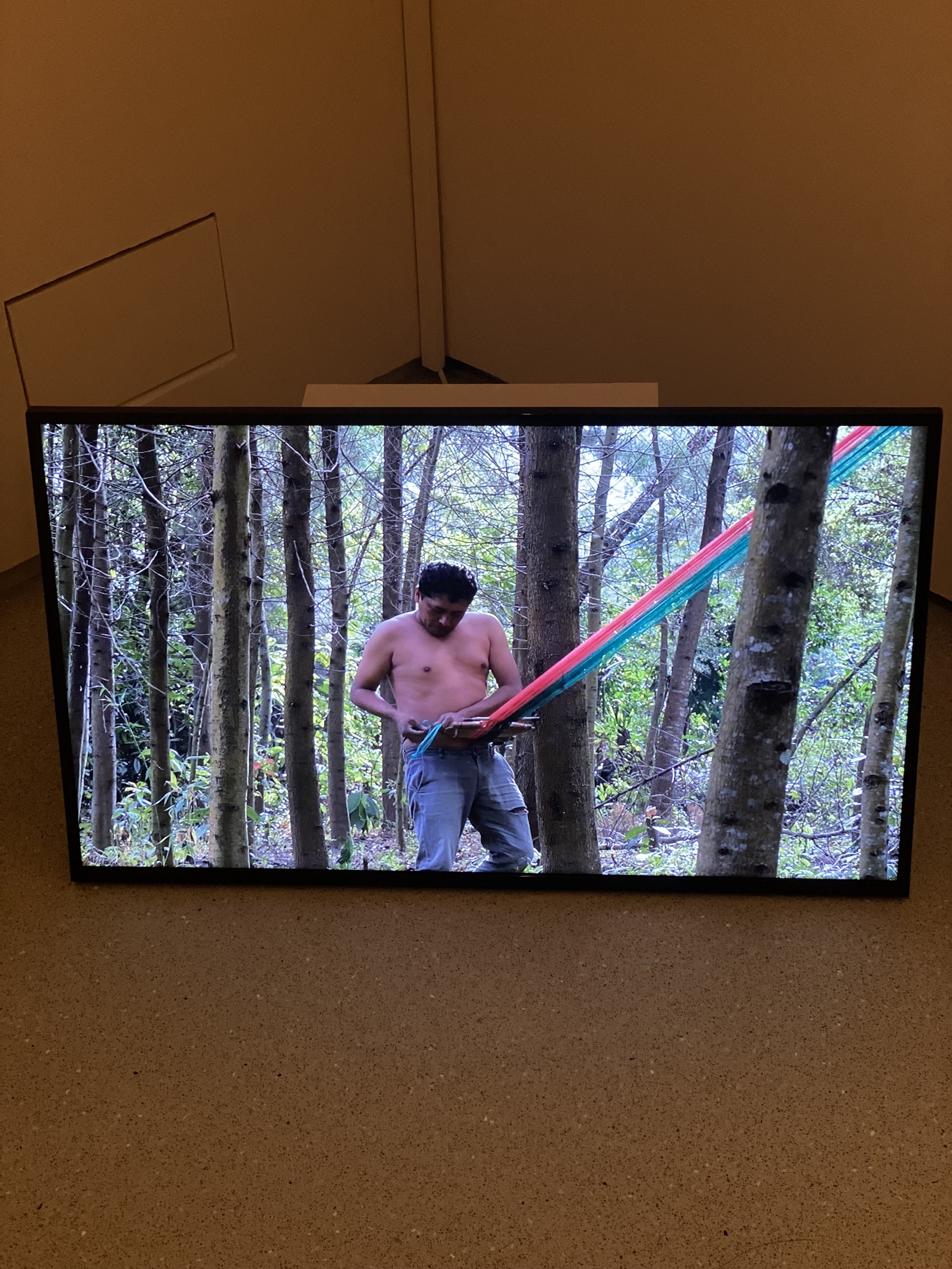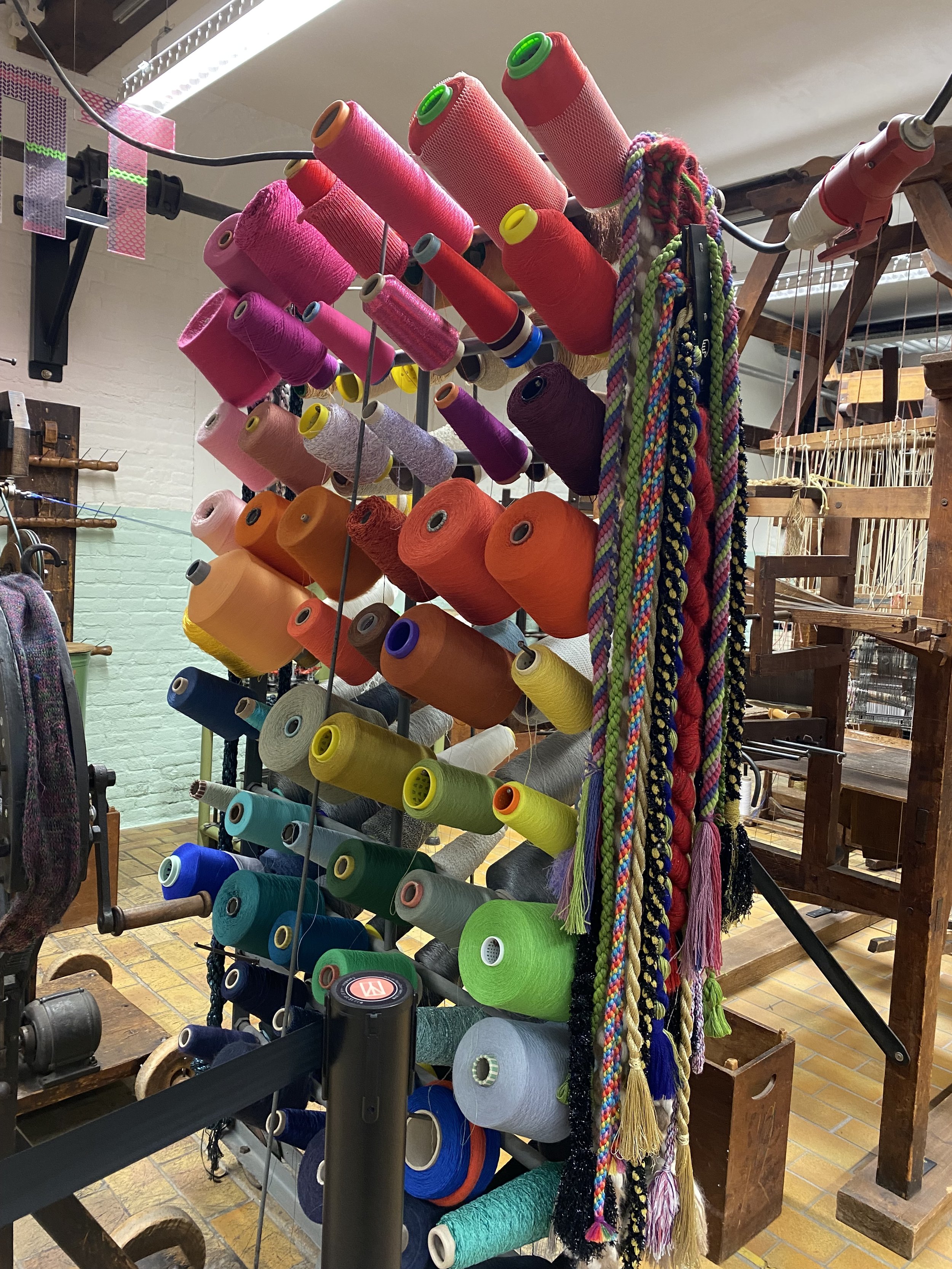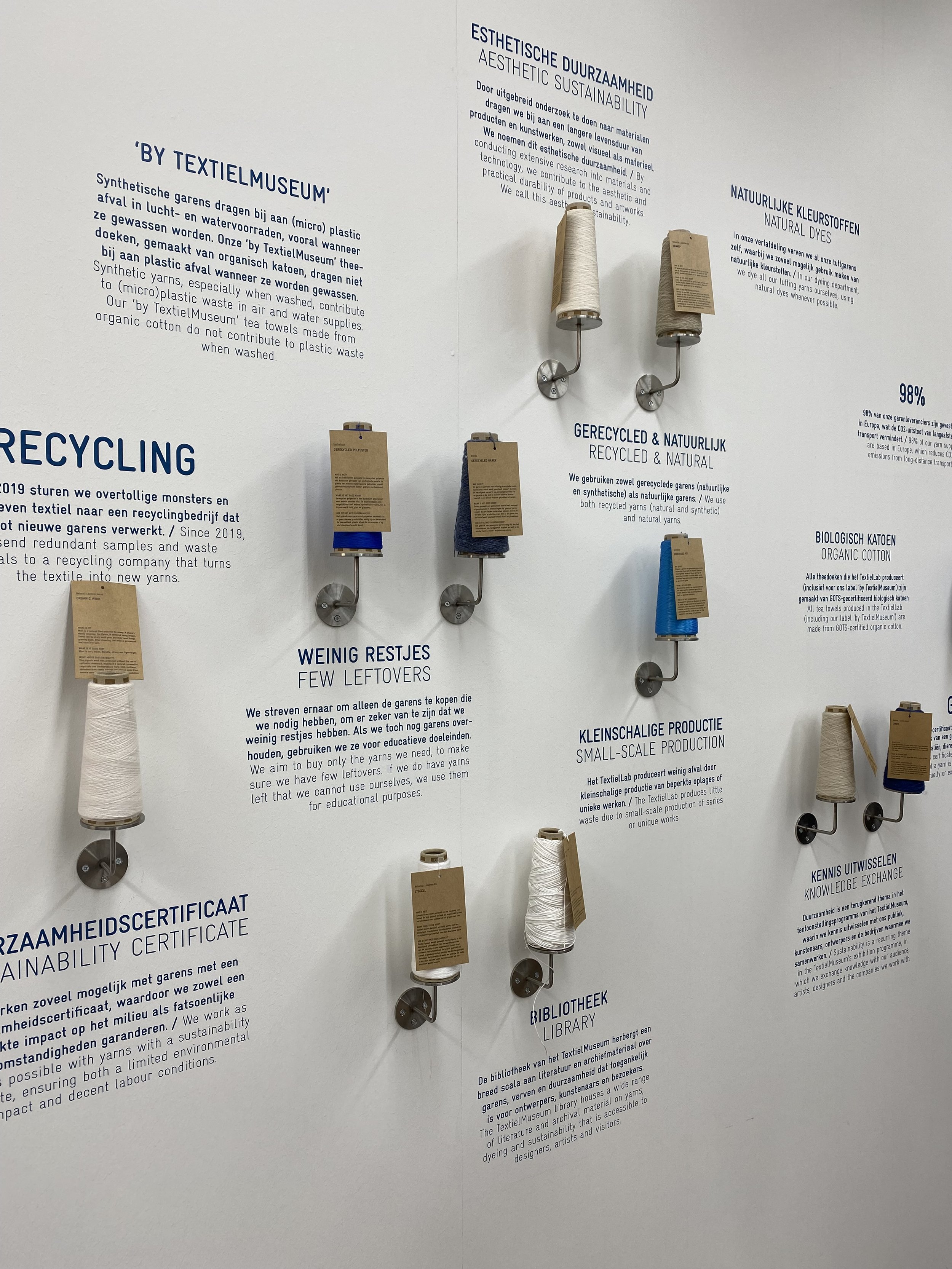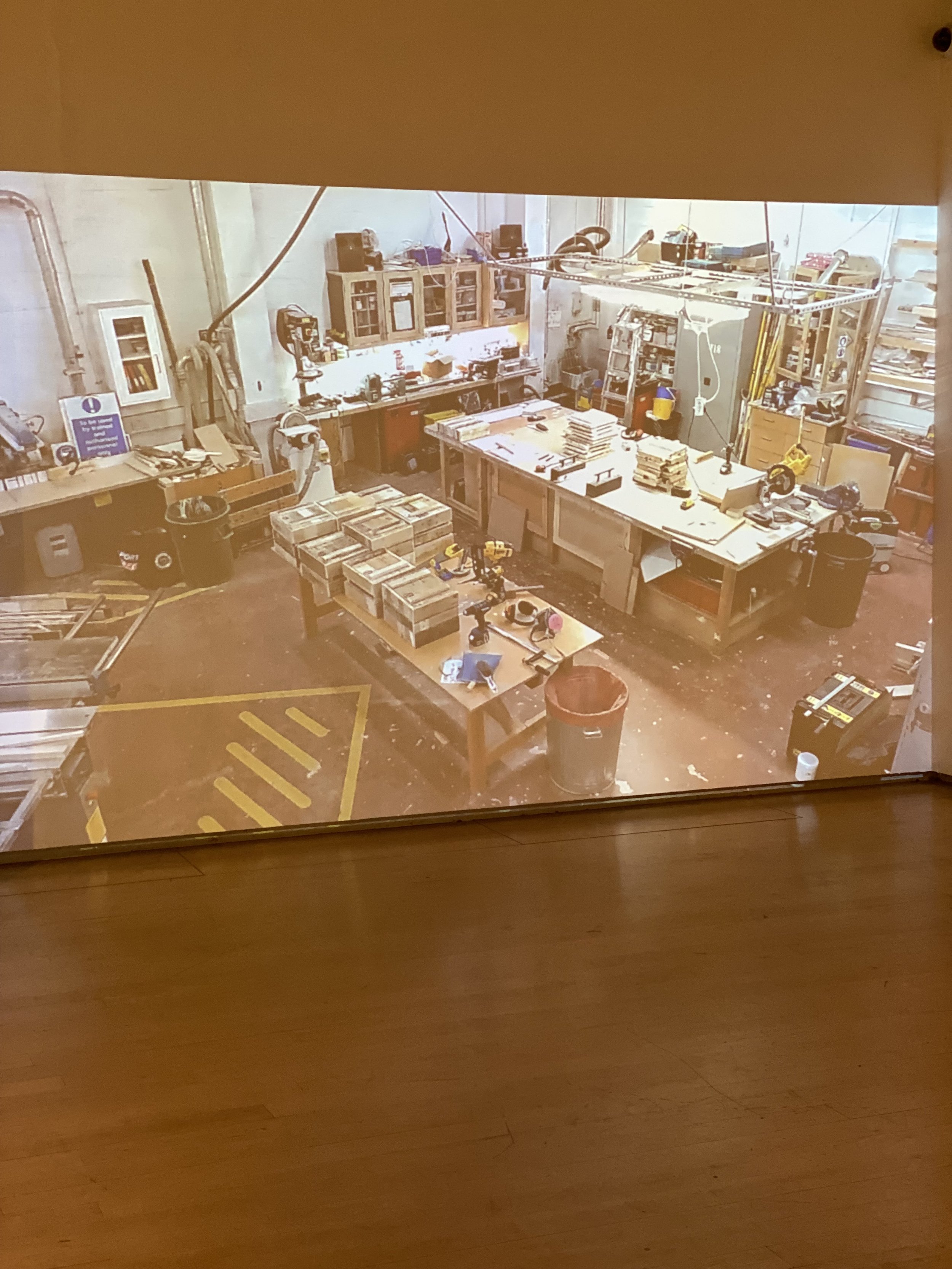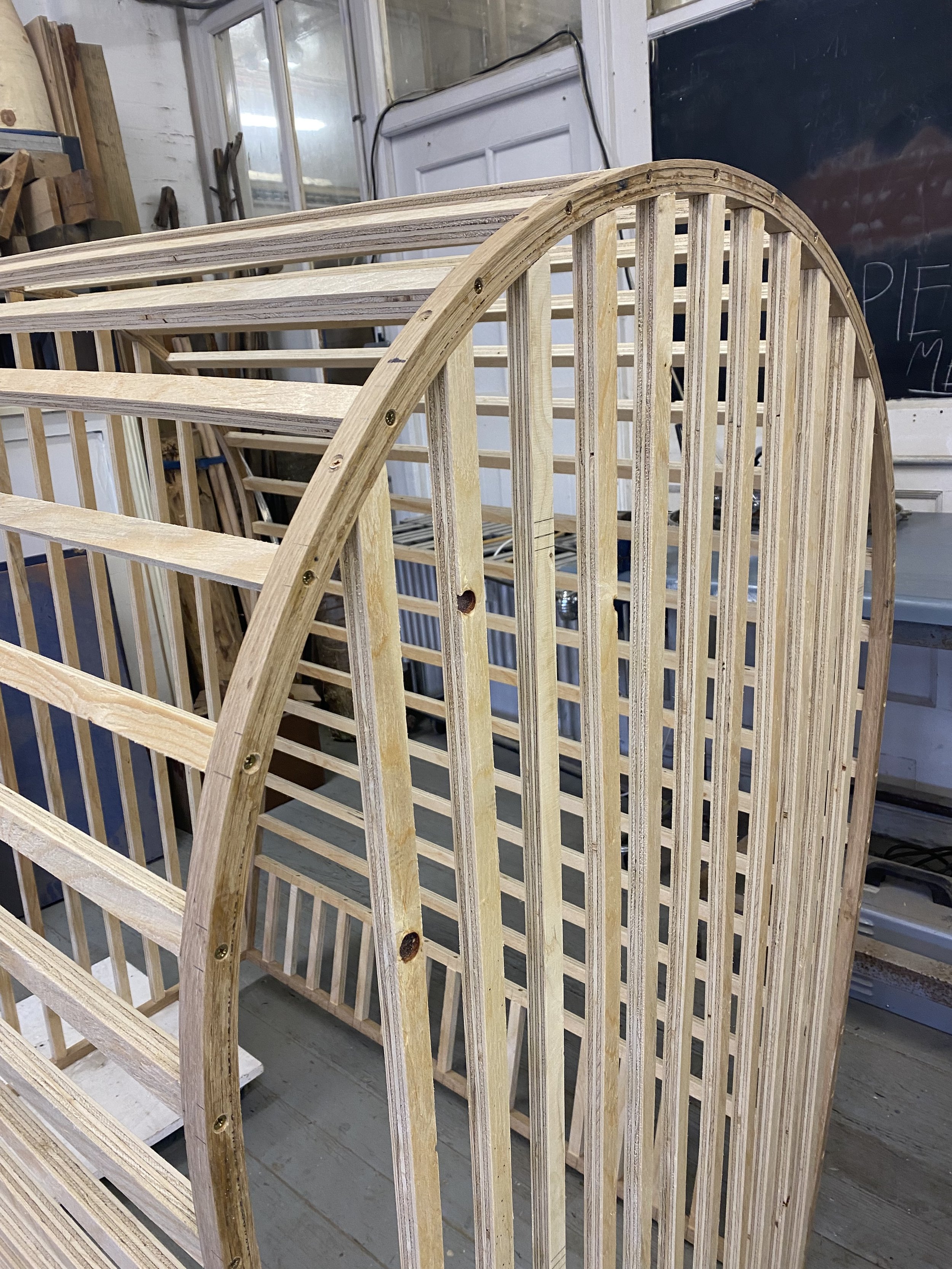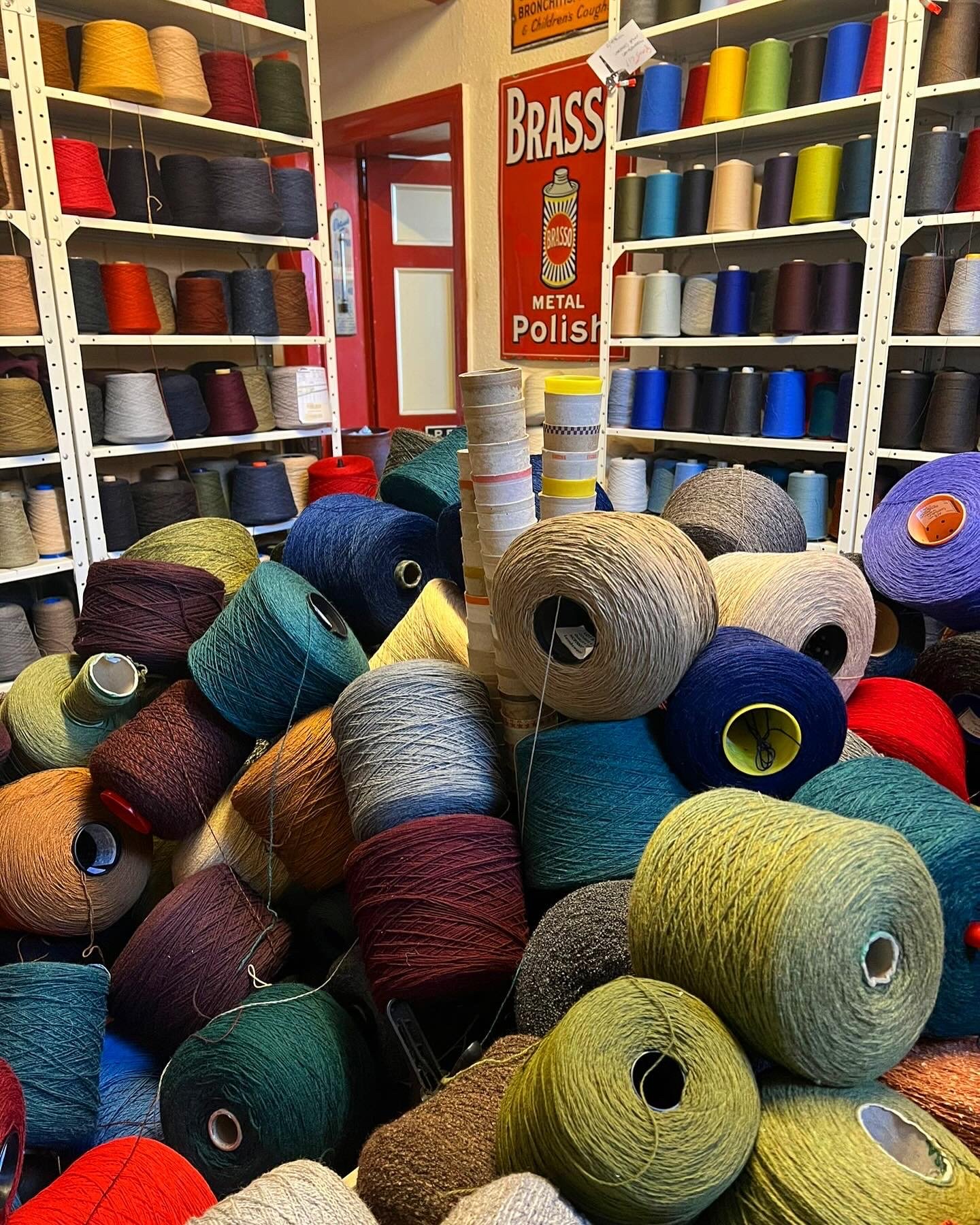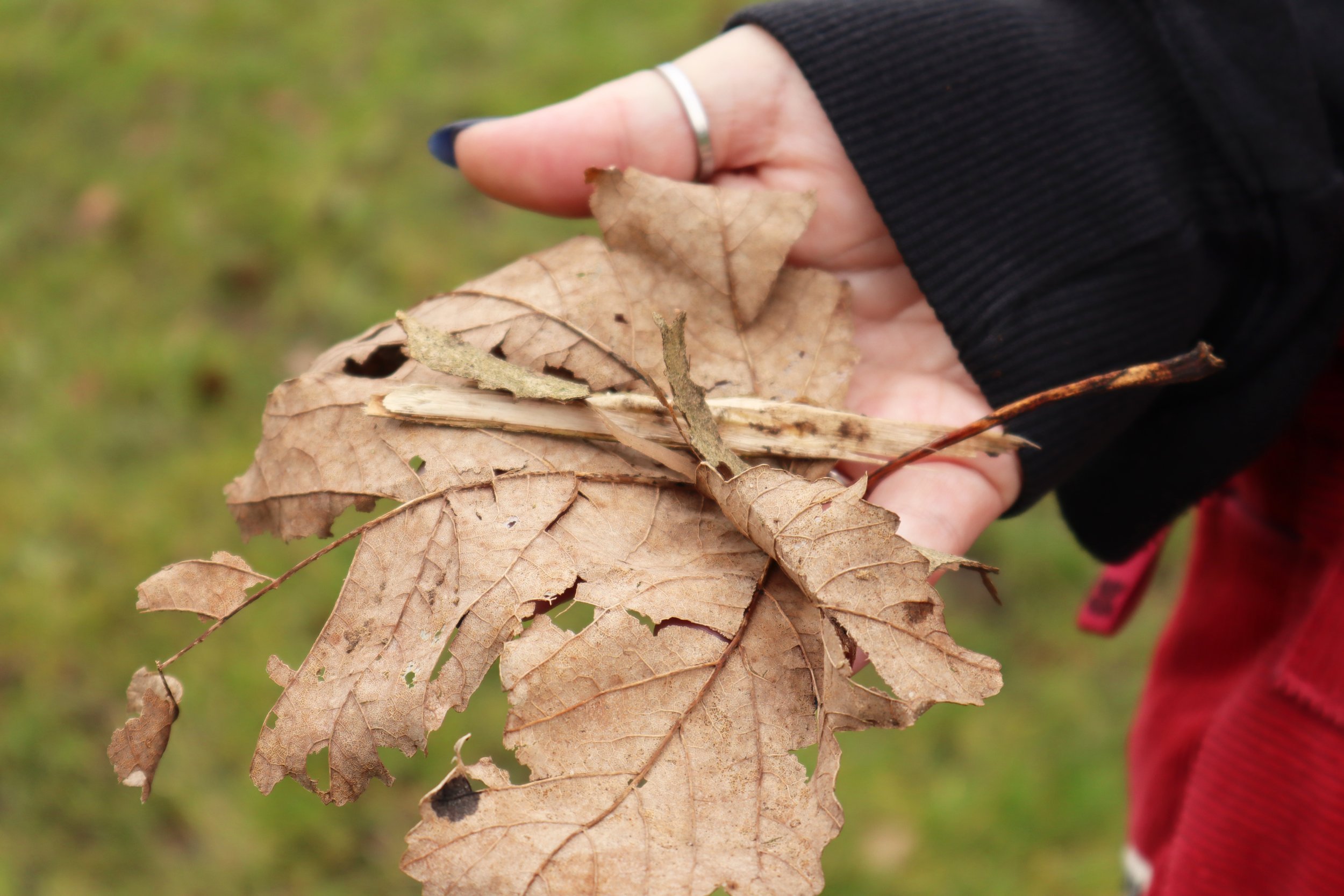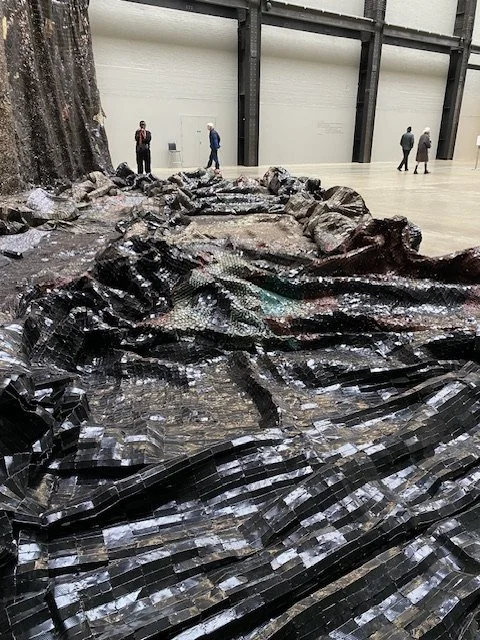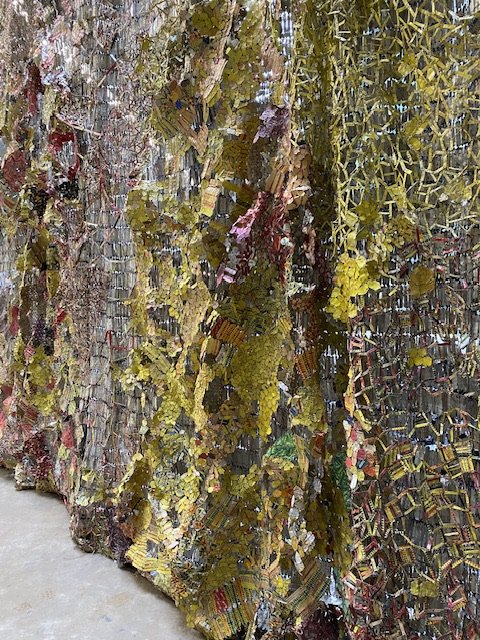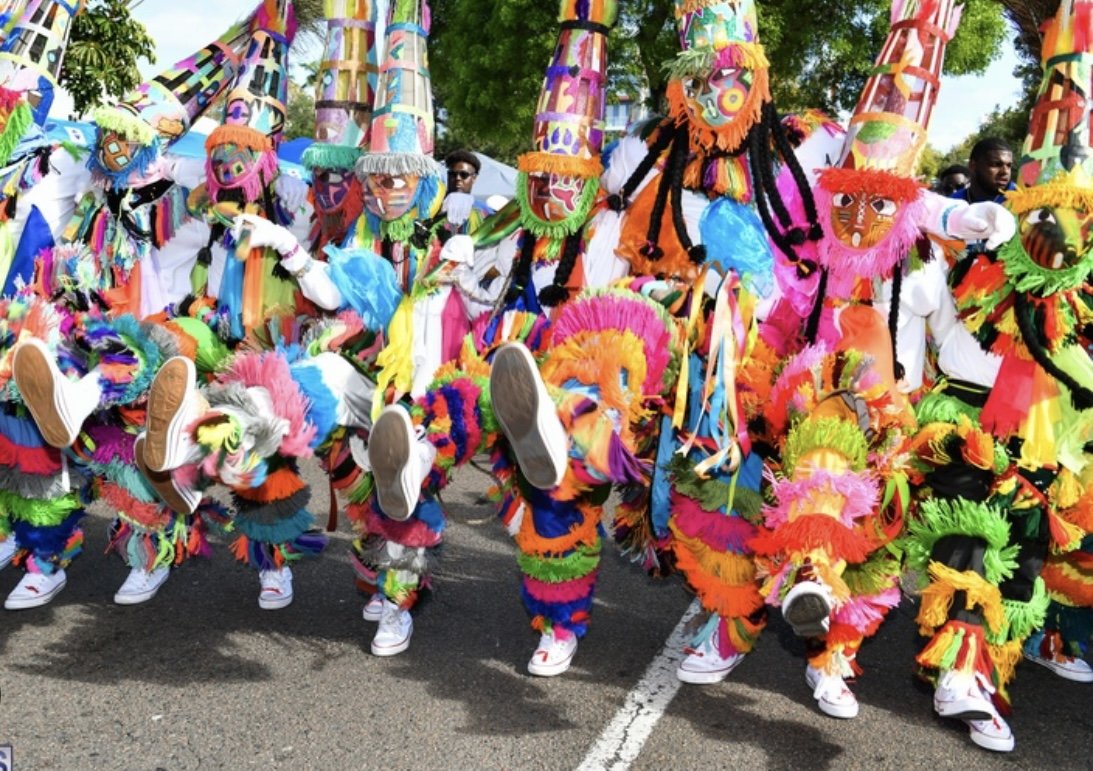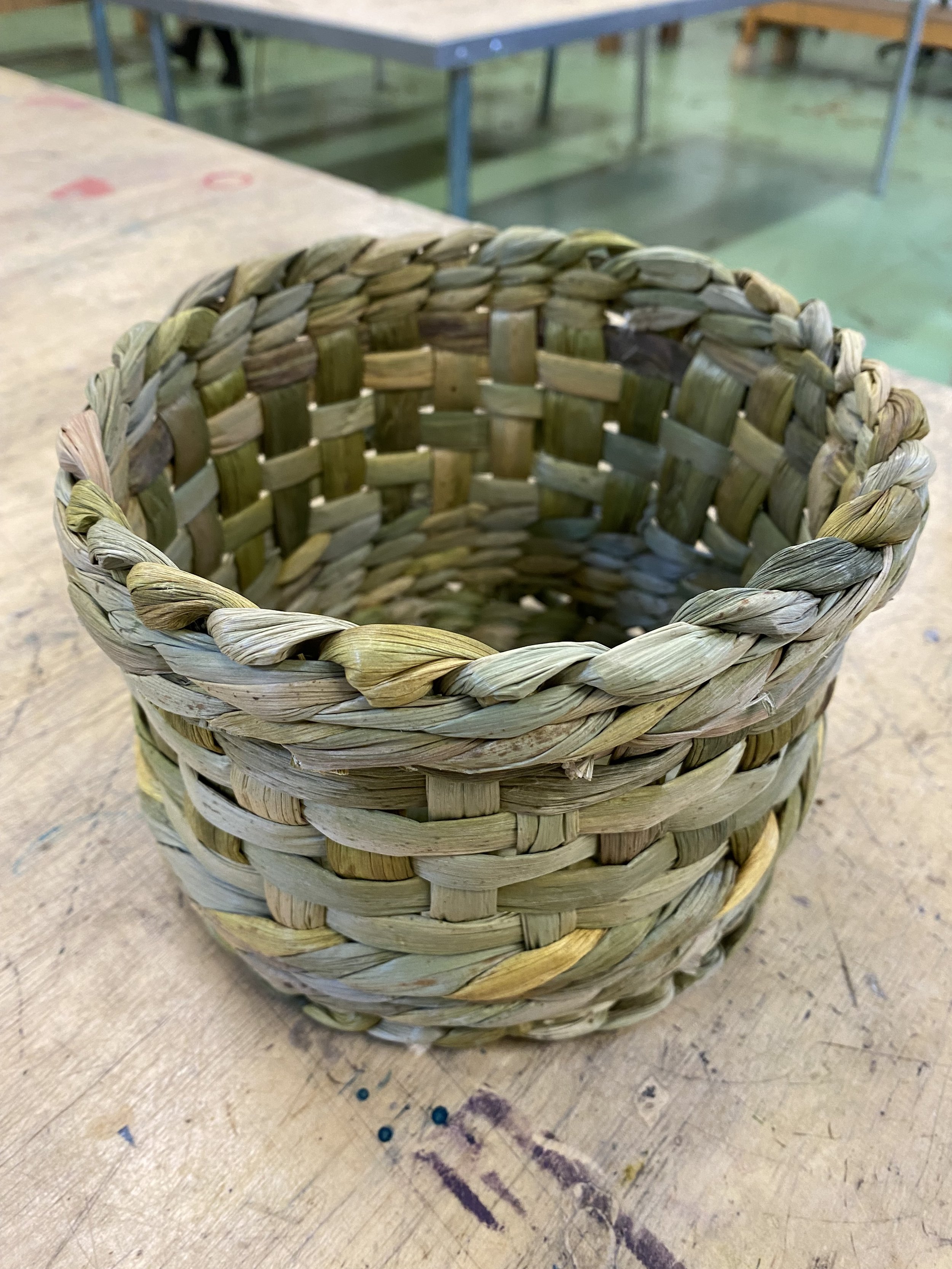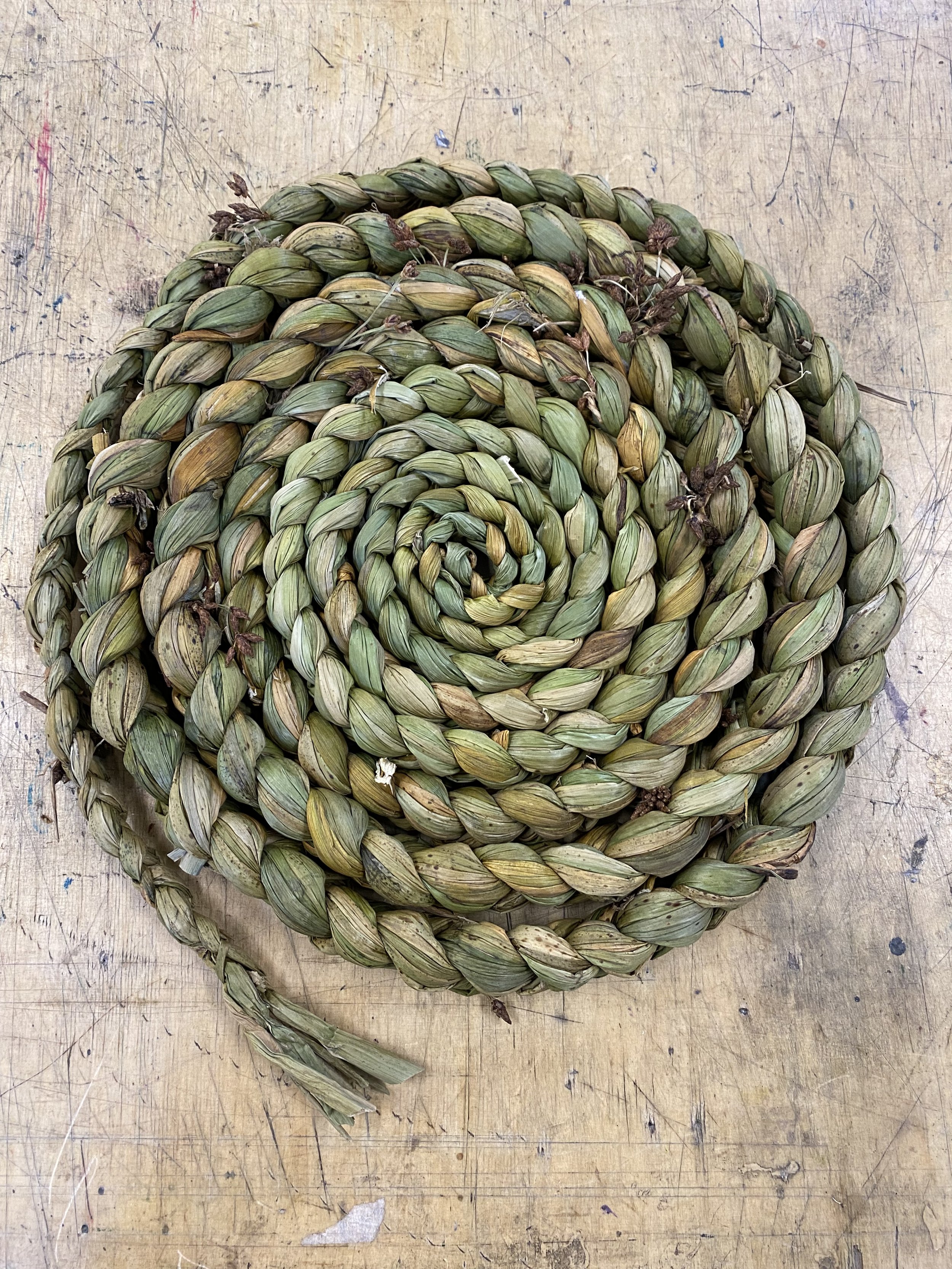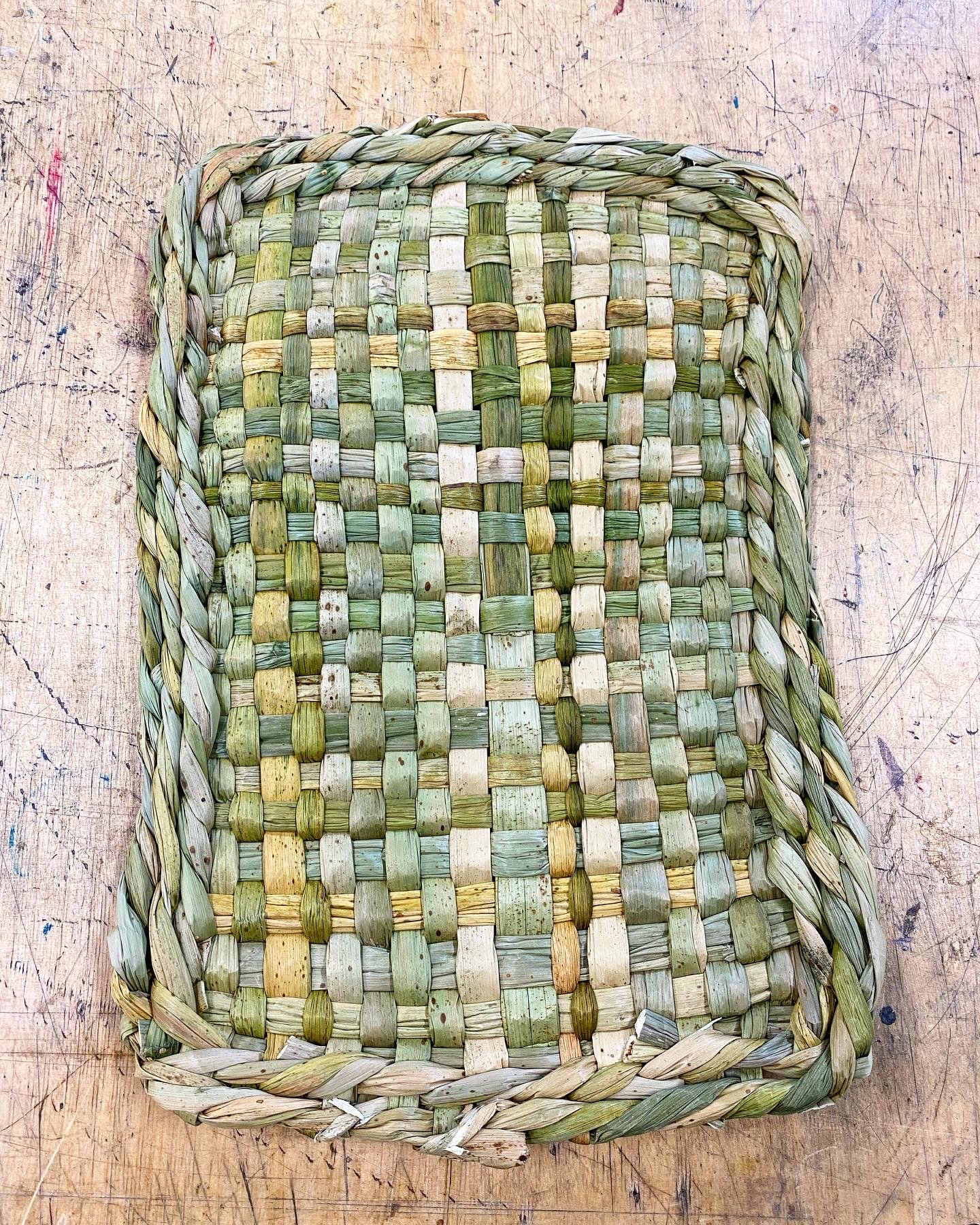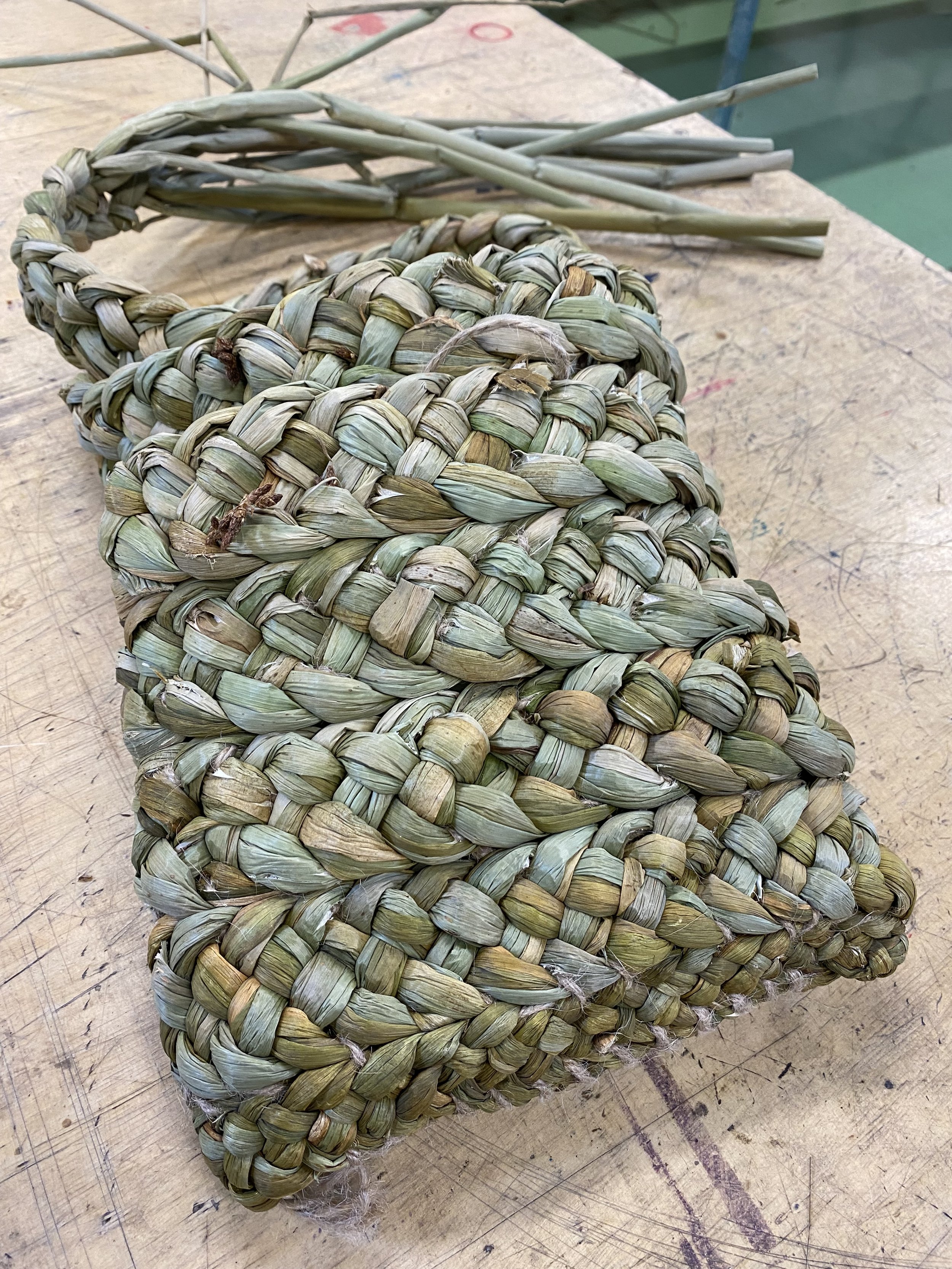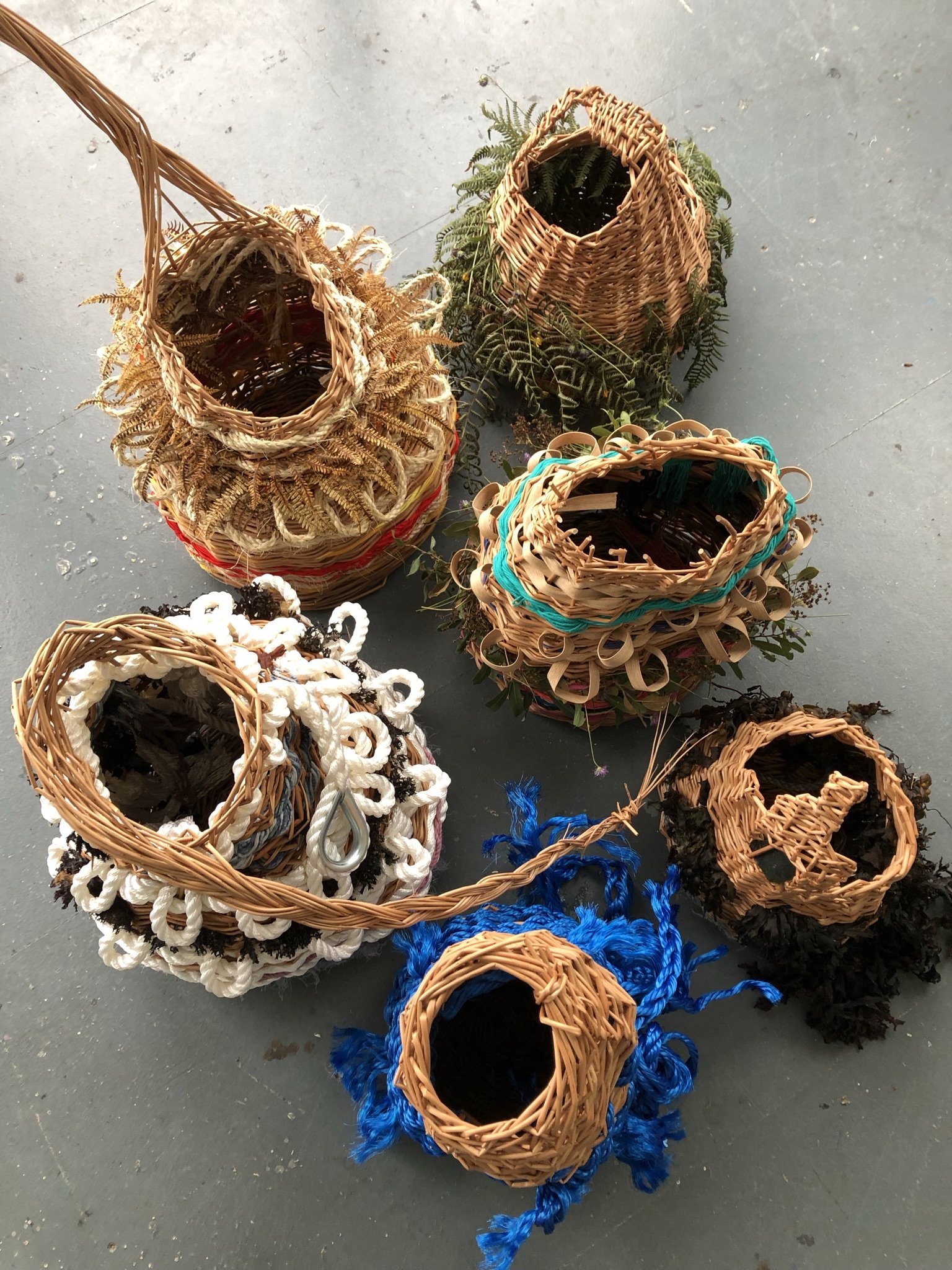RITUALS FOR TOMORROW
2023 - 2024
Rituals for Tomorrow is a new research, engagement & production project by visual artist Jenny Steele to identify sustainable ways to use weaving with everyday wild plant life, that supports our wellbeing, connection to nature and sense of belonging.
Working with partners Art Gene, Barrow, Cumbria; Rogue Artists Studios, Openshaw, Manchester and a series of individual creative practitioners, a programme of weaving and wellbeing workshops on each site will work towards the development of two large scale artworks using local flora. A collection of short films sharing weaving techniques, plant life and personal narratives will be created from the project and shared widely post project.
Rituals for Tomorrow is supported by a Project Grant from Arts Council England.
Weaving Sessions in Gorton, Manchester
26th April 2024
Over the last two weeks we have held the last sessions in learning to weave with the backstrap looms with ex industrial yarn and plants. The participants in the sessions are a group of female members from the former Gorton Visual Arts Group. They are all beginner weavers, although they are used to learning and picking up new creative skills throughout their community projects over the years.
They all did incredibly well getting the rhythm of weaving with a back strap loom, and as always we learnt the best through making ‘mistakes’. Weaving is detailed and patient work, and often you could hear a pin drop with the concentration in the room, although we had a lot of conversations about adjacent crafts, sourcing materials and ideas to continue weaving at home after the project.
Over four weeks the group have learnt how to do plain weave, weave with plants, and create a decorative scallop edge with ribbons. We also learnt how to make tassels with a braided top, which are already included in the sculpture. The leaves we have used were crocus leaves and daffodil leaves from the Fallowfield Loop and local parks in Gorton.
We used backstrap looms created by artist Raisa Kabir in her edition with curatorial arts organisation, Panel Glasgow. Each woman that takes part in the project learnt on her own loom which keep and take home free to undertake more weaving post project. They each come in a lovely printed bag too for transportation in you want to weave in outdoors. There is a link to purchase the loom here
All of the participants weaving will be included in the sculpture. With special thanks to Lucianne Cannavan for her assistance and to Rebecca Davy for her help and taking part.
Images above left to right: Sue with her final length of weaving, group weaving on backstrap looms in session 4.
Images below, left to right clockwise: Margaret weaving on the backstrap loom, Rita with her final length of weave, weaving by Julie, Rebecca with her final length of weaving and weaving by Sue.
Lucianne Canavan
19th April 2024
As part of Rituals for Tomorrow, I offered two work experience placements to graduates of Manchester School of Art’s degree, Textiles in Practice. Following meeting students at last year’s impressive Portfolio Review Day in April 2023, I created an open call from which two graduating students were selected. As part of the paid work experience, primarily focusing on assisting in workshops and working towards a large sculpture using textiles, they would also receive bespoke mentoring from me on their developing practice and creative career.
Lucianne Canavan is a multidisciplinary artist and designer with a strong focus on the importance of sustainability, mending, wellbeing, and an interest in both weaving and stitched textiles. Lucianne is clearly passionate about the positive effects that creativity can have on our wellbeing and mental health and is committed to working with people in a variety of contexts to develop her work.
Prior to undertaking the Textiles in Practice degree, Lucianne has successfully completed a range of Art and Design courses in Further Education in other creative disciplines, including a Foundation Diploma, as well working in a variety of employments including care and hospitality. This has given her an understanding and self-awareness of the areas of work she would like to pursue long term, with people and creativity at the heart.
She has two strands to her making practice – stitched textiles which includes ‘mending’ and woven textiles. Lucianne has combined these two interests to use her woven lambswool as patches on clothing. The act of ‘recycling’ clothing, saving it from landfill, is as important to her as the caring act of taking time to give ourselves an opportunity for a meditative and creative moment.
Lucianne has brought her fantastic weaving knowledge and enthusiasm for working in a community environment with textiles to the project. She has recently set up Thread Ends Weaving Studio with fellow weavers Lilly Frances Beards and Caitlin Binks at Islington Mill, and is based between Warrington and Manchester.
Read more about Lucianne in this Green Grad feature on Design Milk about her practice here
Unravel – The Power and Politics of Textiles in Art at The Barbican Centre
11th April 2024
Last week, I had the absolute pleasure of visiting the current exhibition ‘Unravel – The Power and Politics of Textiles in Art’ at The Barbican Centre, London. I had been looking forward to this, and it absolutely did not disappoint me. I booked a post 5pm ticket on a Thursday (this is when tickets are Pay What You Can at The Barbican) and I could have stayed much longer than the near two hours I spent in the exhibition, but I had a pre booked train to catch back to Manchester.
I really enjoyed the ‘thoroughness’ of this show, I thought the exhibition was very well curated and presented and had a well communicate narrative to it that held the works together in a clear context the viewer could relate to and empathise with. I felt the co-curation between the Barbican Centre and Stedelijk Museum, Amsterdam (which the exhibition will travel to in September 2024) examined and considered so many aspects, feelings, and meanings as to why artists may choose to use textiles in their artwork. It also took us on an international journey, sharing artists work I had never come across before, processes and localised traditions, often sharing harrowing and distressing histories that these textiles helped them come to terms with. The exhibition was split into subsections such as ‘Ancestral Threads’, ‘Wound and Repair’ and ‘Bearing Witness’.
Some of my personal highlights were the following works:
Above left: Yee I-Lann with a group of listed weavers, TIKAR/MEJA, 2018, Bajau Sama Dilaut pandan weaving with commercial chemical dye and matt sealant
Above right: Jeffrey Gibson, Speak to me so that I can understand, People Like Us and We Play Endlessly, 2018, repurposed quilts, polyester, vintage beaded hair barette, vintage applique, assorted glass, tipi poles.
Below clockwise (left to right):
Acaye Kerunen, Ayelele, 2024, palm leaves and raffia. Made in collaboration with Ugandan women using binding, weaving and plaiting techniques learnt from female community leaders.
Georgina Maxim, Dear Fesmeri and Mareni, The Dress Doesn’t Fit, 2022, Textile and Mixed Media. A way to commemorate and process the traumatic loss of the artists mother at age 3.
Magdalena Abakanowicz, Vetement noir (Black Garment), 1968, sisal, iron and horsehair. I love the grubby, earthy, buried shroud like quality to this work. It is really over powering and unnerving.
Antonio Pichilla Quiacain, Cordon Umbilical, 2021, Single channel video, filmed and edited by Jaime Leonardo. Back strap is a process I use for its flexibility and feeling connection to place, and nature.
Unravel – The Power and Politics of Textiles in Art continues until Sunday 26th May at The Barbican Centre, London. More information here Unravel | Barbican
Making Tassels - Workshops
5th April 2024
This week we began workshops at Rogue Artists’ Studios with former members of Gorton Visual Arts. The art group, which has been running for 18 years, created a wide range of ambitious creative projects, but sadly closed last week due to its leader deservedly retiring. They launched their last site-specific work, a mosaic about Gorton Tank, at Collier House, Gorton in late March.
Several of the group will be working with me on this project where I am sharing new skills with them in passementerie, in this case tassel making and cord winding and weaving with backstrap looms. Although they have used stitched and printed textiles in their projects, such as banners, this is the first time they have worked with constructed textiles. We will also be weaving with local plants such as grasses and flora to be attached to the large sculpture.
In workshops, we are also lucky to have the assistance of recent graduate Lucianne Canavan. Lucianne graduated in 2023 from Manchester School of Art with a degree in Textiles in Practice, with a focus on stitched and woven textiles, with a special interest in sustainability. She was selected from a call out to their students, alongside another graduate to assist on the project. As part of part of a paid work experience opportunity, I will also provide mentoring to them on their developing practices. I’ll share more about their own work in future posts.
We started this week learning how to make tassels with a plain binder and a plaited braid. Using the ex-industrial cotton and mercerised cotton, we followed a simple method I use to make tassels wrapped around cardboard, tying with a doll shaped top and a braided attachment . We created our own plaited braids in three colours working from table to create a tight plait. Their beautiful tassels will be attached to one end of tassels and some took their tassels home also.
As we worked we had some great discussions about weaving, plaiting, schools, art and the importance of arts and crafts in every day to bring joy and happiness.
Martin Puryear
26th March 2024
I was listening to a podcast on sculpture recently that quoted the artist Martin Puryear saying, “I became more interested in making things, rather than making images of them”.
Although, I always envisage myself drawing, printmaking and painting in the future I have felt a strong pull to making physical objects the last three or so years, and this statement really resonated with me. An image or representation in response to something else does not feel as satisfying anymore to me, and I feel a need to make an object that takes up physical space. Although, I have worked with significant printed works in installations, it feels quite different to the approach I have always taken before.
Before this point, I had not heard of the work of Martin Puryear (born 1941), an Afro-American artist. His work is beautiful, considered, and minimal yet focusing on, even revering, the process of traditional crafts. He reportedly learnt the beginnings of these skills as a child, making boats, musical instruments, and furniture. I am interested in how he references the process and symbolism of craft whilst creating impactful sculpture, but not getting ‘carried away’ by the technique.
I was first struck by the work, Night Watch (2011), Maple, Willow (above left) which features willow stakes held into a rectangular base, shooting upwards. The even, layered placement of the willow suggests the care taken by a craftsperson; the upwards pull mimics the carefree grasses we see in fields that can be used in weaving. I think about my own process using willow, choosing, or cutting the stakes, separating them, measuring them, placing them, following the necessary the rules to hold things together three dimensionally.
Other works are suggestive of woven structures and traditional techniques, such as shaker objects. He seems to strip back the process and object to its simplest form. The sculpture appears as an object that could be read in multiple ways, without a clear narrative, but an obvious origin that could be claimed by many.
Textiel Museum, Tilburg
18th March 2024
Last week I visited the Textiel Museum in Tilburg, Netherlands. Located in a former woolen blanket factory, the post-industrial building appears as if it could be in Manchester. I have wanted to visit for a long time, as I have been interested in how the museum functions as both a museum and workshop where artists, designers and makers can create works in a range of processes.
The museum has several exhibitions on at one time, both exploring the history of textiles and displaying work by contemporary artists and designers that use textiles in their work. The exhibition spaces are also accompanied by a series of live workshops and labs where you can see textiles being made in the processes of tufting, weaving, knitting, embroidery, passementerie and laser cutting. You could not touch the works in progress, but you could easily walk around and look at textiles being made behind a barrier. Some of the makers were present and you could ask questions, but not take any photographs of this part of the museum. In the weaving area, several works were being woven in progress by digital looms.
The historical exhibitions shared an interesting history of the former woollen blanket factory workings. I though all exhibitions were incredibly well designed, with a strong focus on tactile touch and interactivity, as well as communicating both visuals, words, and sounds. I am strong visual learner and always appreciate a diagram over a description. There was also an in-depth display of historic looms and their punch cards.
The contemporary exhibition, Is it Alive? shared unsettling work that combined traditional textile techniques with technology. The centre piece is I am Storm by artist duo DRIFT (Lonneke Gordijn and Ralph Nauta). The new installation consists of twenty large blades of grass that wave on an imaginary breeze. Other exhibits include the unique ‘living architecture’ by artist and architect Philip Beesley/Living Architecture Systems Group (LASG), an activated look by fashion designer Iris van Herpen, two interactive works by Bart Hess and extended work by Tanja Smeets.
Textiel Lab encompasses the making and research-based areas of the museum, which also include sample areas, examples of past works made on site, such as a large collection of woven blankets. There are also displays of sustainable and natural textiles and yarns that they have experimented with extensively. Many were types I had never heard of, so I need to spend some time researching these more.
Artists, designers, and makers can apply to work with the Textiel Lab to use one of their processes with specialist advice. Accepted applications can take around a year to be programmed for making to go ahead. It was such an inspiring visit, and it would be wonderful to work there some day on a project using their expertise and equipment.
Above: Traditions of Care, Lockdown Project, Lucy Wright
Lucy J Wright
9th March 2024
Recently artist Lucy J Wright visited my studio to talk about our shared interests. In recent months, I have followed Lucy’s energetic and performative work with interest online, and several people suggested it would be useful for us to connect. References to ‘folk art’, particularly costume and ritualistic objects, are apparent in my work, although this is an area I am not seeking to research in depth or particularly work in response to. However, I was interested and very curious about Lucy’s ways of working, in particular the performance and costumes she makes.
Lucy is an artist based near Leeds and her multidisciplinary practice sits at the intersection of folklore and activism, often using as source material the large personal archive of photographs and research she has gathered over nearly a decade of documenting female and queer-led folk customs.
Lucy was previously the lead singer in BBC Folk Award-nominated act, Pilgrims' Way following which she received the Vice Chancellor’s scholarship from Manchester School of Art for her PhD (2014) before becoming a Visiting Research Fellow in Folklore at University of Hertfordshire in 2019.
I was interested how, through her in-depth knowledge of folklore, Lucy creates new traditions, such as ‘Dusking’. Lucy describes dusking as ‘a newly invented tradition, conceived as the counterpart to the morris dancing that takes place on 1 May marking the arrival of summer. Taking place instead on 31 October, at Dusking we ‘dance the sun down’ while honouring the equal gifts of rest, reflection and replenishment associated with the darker months of the year’. This inventive, ritualistic way of moving through the year, being marked by collaborative customs, often with a dose of humour, is such a familiar way of working and familiar language to her.
Throughout our discussion about our respective practices and overlapping interests, Lucy recommended a few very interesting references to investigate further. One was the exhibition last year ‘Making Mischief’ at Compton Verney which I sadly missed. It was the first exhibition to present a cross section of the variety of costume used in folk customs across the UK, from morris dancing to Hastings Jack in the Green.
Another interesting reference was the artist film maker Eelyn Lee who recently had an exhibition ‘Four Quadrants and the Sky’, with collaborators on a production and series of sculptures/costumes presented in the gallery. Referring to the ‘four images’ (四象)—the custodians of each cardinal direction (North, South, East and West) in Chinese celestial thinking—it was a year-long investigation on personal and cultural experiences through processes of divination and cosmologies. Of mixed Hong Kong and English heritage, Eelyn spent her formative years in and around her family’s Chinese restaurants in the Midlands. Although I haven’t seen the performance and production, I like how the costumes create a kind of timeless ritualistic identity.
Thanks so much to Lucy J Wright for her time and knowledge. I do hope we can work together sometime in the future.
Below: Dusking, a performance by Lucy Wright and Libby Bove, 2023, Halsway Manor (National Centre for Folk Arts)
Making Up, Jo Lathwood at The Lowry, Salford
29th February 2024
This week I went to visit Making Up at The Lowry, Salford, which is the current exhibition by artist Jo Lathwood, who is also in residence at the gallery for four weeks over two separate periods.
I was recommended to look at Jo’s work in a recent studio visit as she also shares an interest in working sculpturally with a focus on sustainable materials. I met Jo at the exhibition to have a chat about cross over interests and practice in general.
Jo Lathwood is a visual artist based in Bristol and has worked on a variety of site specific commissions and exhibitions throughout her practice. She often works sculpturally on temporary installations with reclaimed wood, which can even be recycled from exhibition to exhibition.
Jo’s exhibition, Making Up at The Lowry follows a cycle of building a platform that visitors could walk along and it even rotated. The wood used was pallet wood collected by the Lowry over several months, and also wood recycled from her recent exhibition at Mirror Plymouth. She has a very hands on process; building the platform herself with technical support which was also live screened from the underground wood workshop to the gallery, which in itself functioned as a durational performance. Jo explained it was important for her to be an integral part of the day to day construction of the work.
When we met the exhibition was at the stage of deconstruction, where the wooden platform was being dismantled into individual wooden storage boxes for gallery visitors to take away and use as they please. The everyday wood used in the exhibition appeared as the main character in the process, that transformed from part of a collaborative stage to part of many functional boxes which also act as souvenirs, dispersed amongst many.
Accompanying the exhibition was a display which shared some of Jo’s research, drawings and also her manifesto for working as an artist, in a sustainable way (below). This approach came about via her own personal beliefs which felt incongruent to the high amount of materials used and left over in storage from in temporary sculptural projects.
Jo also introduced me to the open source website Materiom from which Jo learnt recipes for inks and other materials made entirely from biobased materials. As I understand, her drawings (below) on waste paper exhibited in Making Up were made using such recipes.
With thanks to Jo for her time. I always enjoy open, organic conversation with artists who have shared interests, and the ideas that can arise.
Making Up continues at The Lowry until Sunday 3rd March 2024.
Weaving at scale
23rd February 2023
I recently had a very helpful studio visit/ mentoring session with Suzanne Heath about my practice and my interest in this project to develop weaving in scale, for both outdoor and indoor settings. Suzanne is a freelance project manager, curator and consultant based in Bath who specialises in developing and delivering art projects in the public realm ranging from one-off events to permanent visual art commissions. You can read more about Suzanne’s extensive projects and experience here
Before I began weaving in 2020, I created commissioned sited artworks in both indoor and outdoor settings, and this is a way of working I would like to continue. I enjoy the process of developing ideas, often in discussion and research with the local community and creating a work that can be viewed and experienced in an accessible way.
However, I previously used the process of drawing, painting and printmaking which was then developed into printed works. Working sculpturally with weaving on a large scale, and also considering weather proofing and outdoor conditions, is an entirely different method to previous approaches.
Suzanne and I discussed various factors to consider from construction to maintenance as well as issues regarding conservation and decay, especially with regards to using plant based materials in outdoor settings. I feel a bit as though I have not come into contact yet with a lot of examples of these kind of techniques such as willow weaving and passementerie being used in contemporary art practice, which is not necessarily a negative. One artist she did recommend that I really connected with in this way was Laura Ellen Bacon Sculpture - Laura Ellen Bacon
Laura Ellen uses the willow weaving and straw thatching to create monumental sculptures that comment and interact with the spaces both within interiors and in natural environments. For me the materials are completely transformed into another level, powerful natural forms taking over the space.
Suzanne and I also discussed the use of craft processes in my work and how I want to consider the role of these techniques. I have spent a lot of time looking at places where contemporary craft may be sold or exhibited but I feel strongly the work I am making is sculptural predominantly, rather than a craft object. It is a fine line between the two, which also interests me, but I feel being selective about how works are presented is important to how they are interpreted and experienced.
Laura Ellen Bacon, ‘The Feeling Remains’, 2022. L’Abbaye de Maubuisson, Saint-Ouen-l’Aumone, France
Construction of sculpture internal frames
12th February 2024
The Rituals for Tomorrow project involves making two larger sculptures using weaving of plants and textiles in a wide variety of processes. I use both looms in my work but have also learnt basket and rush weaving and in the studio, I have adapted these processes in different ways in a series of smaller sculptures. Before Christmas I tested out different ways I could hang the different parts of the weaving, as well as developing drawings in watercolour in more detail of each sculpture, which I will share at a later date, as I do not want to spoil the surprise!
I have worked with carpenter and art fabricator Tom Antell to develop these into technical drawings. I was also lucky to work with Tom in 2022 when I was commissioned to make a children’s artwork for the Science and Industry Museum, TEXTILE CITY, and he built the woven structures that small visitors could weave with textile rags.
Each sculpture is sizable and attaches to a moving part, each height is 1.5m and width is 1-2.5m long. The frames are made from strips of wood that are placed in certain directions and locations for the textiles and plants to be woven and attached to. There are also curved elements to the forms, and Tom helped me define measurements and angles to make scaled and 1:1 drawing so we could determine how much materials were needed before he began construction.
Part of the structure has been built from oak wood gifted from a gallery build in North West England that was no longer needed and was donated to their workshop. Again, I like that wood is being recycled and given another life.
Pictures below are of technical drawings, and the processes of splice joints which Tom used to build the curved edges. He cut thin strips of the oak so it would bend and used diagonal cuts to make any joins strong. This is the first internal structure and he is currently working on the second.
Sourcing Materials in a Sustainable Way
5th February 2024
Throughout this project and recent past projects, it has become increasingly important for me to use materials that are sustainable as possible for the environment. As an individual practitioner there is a large amount of waste and damaging carbon footprint in making creatively with textiles utilising fabrics, dyes, yarns and trimmings. Most materials required for fabricating artworks such as commissions, large scale sculpture and individual works in the artworld are purchased brand new from suppliers nationally and internationally, creating further negative impact via packaging and transportation.
There is significant negative effect of the textile industry through water pollution, landfill of discarded used fast fashion, unused textiles, and offcuts (Ref: An Environmental Crisis, OCS 2021). Textiles are the third largest form of landfill. This is not an approach or way of working I want to contribute to in any way.
As well as using locally sourced natural plants, the textiles I am combining with in weaving are mostly recycled, discarded or diverted from landfill yarns and trimmings, apart from around 5% which is newly bought rope required for holding the structure in place. As within a lot of my work, I decided on a general colour palette, which will hold the work together even though the materials and textures may differ. This helps also when items are coming from different places and often have varying widths and tones.
The ways in which I have sourced these yarns and textiles for this project are via the following routes:
* Fairfield Yarns, Heywood sells a wide range of yarns, and some haberdashery which have been collected from a wide variety of industry suppliers. This stock is discontinued, has not sold or unwanted due to closure and would otherwise go to landfill. Each yarn type is sold by the kilo, and stock available varies on each visit due to nature of acquiring the materials. Details on Fairfield Yarns are available here.
* I regularly collect unwanted materials from local textile contacts and for this project I have dyed batches of discarded sisal rope to use.
* I scour charity shops for yarns and trimmings within walking distance. I have gotten to know several local charity shop managers who hold items in the category I am looking for so I can purchase them.
* I purchase job lots of secondhand trimmings and hands on Ebay.
* I have purchased a small batch of recycled ribbon that is made from recycled textiles
Image above- below: Dyed sisal rope, second hand trimmings, Fairfield Yarns, shop interior
Steve Dilworth
22nd January 2024
At the end of last year, I was lucky to host Ann Bukantas for a studio visit. Ann is a Curator and former Head of Fine Art at National Museums Liverpool, and now the honorary Curator at Walker Art Gallery, Liverpool.
Her studio visit was incredibly helpful in a multitude of ways, but one of the artists she shared with me was Steve Dilworth, and he really struck a chord. Over the past few years, I have been moving from working mostly using two dimensional processes, such as drawing, painting and printmaking to working in three-dimensional form. Working in weaving, which often becomes sculptural at the end, if not at the beginning, is a very different discipline to creating panels and working to scale even if they are sited permanently indoors or outdoors. I’m always looking to learn about art made and artists working with similar ideas and materials, and I find myself to be in a completely new area with a lot to learn, which is exciting.
Steve Dilworth is an English sculptor who has lived on the Isle of Harris, Scotland since 1983. Although I haven’t seen any of his works in person, I was really moved by images and films about his sculptural practice and the ways in which he accesses ideas of ephemerality and human vulnerability. There is a constant suggestion of bringing what is going on inside the object to the external surface in a poetic way. His sculptures, in a wide variety of materials and processes bring a tactile experience to what we do not fully understand but are aware of, consciously or subconsciously, on some level in our nervous system.
He sometimes captures elements we believe don’t last – such as stormy water, or mountain air, and encases them in a harder outer sculptural material such as bronze, stone and wood. There are aspects of mummifying or resurrecting aspects of our reality we consider to not to fully exist, yet they are very much in our experience of the world.
His objects are often held in the hand, and he talks about them being ‘power objects’, “All things contain energy. It is self-evident, and by changing their shape or position you can alter the energy or strengthen it. You end up making power objects and that is ultimately what sculpture is for me. It is not primarily visual art. An artist creates music, art or whatever but it transcends the material. Otherwise it is worthless. If it isn’t more than the material, then it is not art.”
In the vessel like sculptures I make, there is an aspect of holding things that aren’t physically tangible but there on a metaphysical level. If you were to put your hand inside the vessel it is empty, but the outer shell carries a decorative, joyful and very tactile dress that mummifies an ingredient that is very important but not necessarily physical. I am feeling my way through this process and the ‘meanings’ behind the work. There is an aspect of protecting and celebrating a very precious truth which has many parts.
I have shared some selected images of Steve Dilworth’s sculptural practice. I hope to see one of his works in person soon.
Below left: Calm Water Stone, 2020. Below right: Stormwater, 2022 Above: Three Herons, 2003, Heron, dunite, fishing hooks, swivels, and gold leaf.
Below bottom: Three Herons, 2003, Heron, dunite, fishing hooks, swivels, and gold leaf.
Forest Bathing with Spark Artists Network members led by Artist and Shinrin Yoku Leader Niki Colclough
15th January 2024
On Saturday 11th January, Artist and Forest Bathing Leader, Niki Colclough led the first forest bathing walk with members of Spark Artist Network around Debdale Reservoir and Park.
Niki Colclough is an artist with a socially engaged practice, with a focus on care, wellbeing, and the environment. In 2021, she trained as a Shinrin Yoku (forest bathing) leader and has since incorporated these techniques into work. Shinrin Yoku is the process of relaxing one’s nervous system through engagement to nature in the forest environment. Shinrin Yoku was developed in the 1980’s within Japan as a health therapy and has been proven through research to help support immune system, mental health and decrease blood pressure and the stress hormone, cortisol.
The first forest bathing session was held with members of Spark Artists Network, on the last day of their exhibition at Rogue Project Space, Artist Interventions in a Time of Crisis. Spark Artists Network are a group of North West based artists who want to intervene the trajectory towards climate breakdown. They have been meeting since June 2022 and the artists examine how their interventions can affect change, questioning whether art can be productive with or without overt activism.
We met at Rogue Artist’s Studios and as a group we walked to Debdale Reservoir and Park. Niki led us expertly through various exercises as we moved through the natural environment, from observing sounds, responding to prompts and questions, looking at and collecting colours in nature and finally engaging with a tree through a timed meditation. I particularly enjoyed this last quiet meditation and felt thoroughly refreshed by the end of the walk.
Niki kindly ended the walk by sharing some home brew tea she made with the group in their keep cups, which was followed by another ritual of selecting an object from the environment, and by throwing it into the water, choosing something to let go of.
From the walk we learnt short meditative practices we could implement on our own or share with others. A huge thank you to Niki for her guidance and knowledge, all Spark artists who took part, Spark curators Sophy King & John Paul Brown for their co-ordination.
Cord Winding
13th December 2023
Over the last few weeks, I have been testing out how to use to my cord winder to combine textiles that could be used in the large-scale sculptures. Cord winding is part of passementerie, the technique to make tassels and trimmings for a variety of uses. I purchased this cord winder from Anna Crutchley who is a master passementerie artist. Anna makes the cord winder herself from a variety of components, and although a bit more expensive than others that are available it is very sturdy and can handle a lot of use.
I’ve been testing using a variety of materials and how the feeling and strength of the cord can change dependent on the textiles used. It’s also fun to use as it’s always a surprise to find out how the cord will turn out!
I have developing cords into tests and ways of working that could be translated into part of the larger artworks, in these mini pieces. I made a few larger tassels using thicker cords to create the tassel cup. On one (that features the yellow) I also tried plaiting the cord, but I felt it didn’t really add anything to it and lost the texture of the cord in the process. An interesting feature of passementerie are threads been pulled through beads or other moulds to change the direction of the textile and I have started to experiment with this here.
I have also tried stitching together the cords to create circular and square (ish) shapes as well as how to attach and curve the cords at parts of the main body. I am particularly happy with the circular shape that has tassels all around the outside and a mixture of cords spouting out the centre. So many ideas about how to potentially use these techniques!
The Silent Weaver Costume at Horse and Bamboo Theatre, Rawtenstall
4th December 2023
A few weeks ago, I was lucky to visit the archive of costumes at the Horse and Bamboo Theatre in Rawtenstall, Lancashire. I specifically went to see the hand-woven costumes from their production of the life story of ‘outsider artist’ Angus MacPhee from around ten years ago. This was a touring performance focused on the experiences and creations of this outsider artist, who was named the ‘silent weaver’.
Angus was born in South Uist but spent fifty years of his life in the former Craig Dunain Hospital near Inverness following his return from war II. Angus suffered early years trauma, losing his mother at a young age, which was retriggered in combat during World War II. His mental difficulties on his return meant he was admitted to Craig Dunain Hospital to be supported, although he never received any medication. Angus reportedly did not speak but spent his days weaving items and clothing from grass using an unusual looping technique he learnt on his Croft in childhood.
Angus’s work was discovered by art therapist Joyce Laing in 1979, and what remains of it is held in collections of Outsider artists across the United Kingdom. It has since been referenced in books, film and song in Scottish popular culture, giving him the name ‘The Silent Weaver’, from the book by Roger Hutchinson. Angus lived a quiet life tending to animals and weaving in the hospital grounds, and research into his life suggested he did talk to those close to him in daily life in Gaelic, and also returned to more fluent more speech when he returned to live in Uist towards the end of his life.
Textile artist Joanne B Kaar was commissioned to create the costumes for the show which are replicas of Angus’s original works. She has employed similar techniques such as plaiting and looping, which for longevity have been attached to fabric underneath. There is an interesting interview with Joanne on Craft Scotland blog here
The ceremonial coat is the most curious, Angus also wove sweaters and other garments; there is such a significant difference in texture between the rough grass and the style of clothing. He never communicated whether he wished the garments to worn or not, or if they had any purpose.
Horse and Bamboo’s production toured for several months across North Scotland and other venues across the United Kingdom. You can view footage of their performances here
*
Thank you to Jenn at Horse and Bamboo Theatre for welcoming, preparing and sharing the costumes for me as well as the tour of their workshops & theatre.
Image credits for the documentation of the costumes used in this post are by Richard Tymon Photography.
With thanks Ann Bukantas for letting me know about the costume and connecting me.
Painting in ‘folk art’
27th November 2023
As part of the two artworks in this project, I will be using two existing wooden forms. At Rogue Studios, Gorton, the artwork will be based around a wooden cart that I purchased from a farm sale in Rochdale that is purported to be around 200 years old. The work in Barrow in Furness will be formed around a boat, that I obtained from a kind retired gentleman in Lincoln, who built the boat from wood with a kit, oddly pretty much around the year of my birth.
As some of the parts of the wood will remain visible, I have been toying with the idea of painting sections of these, as I paint and draw in other parts of my practice. I have been looking at hand painted objects in ‘folk art’, especially in the book ‘Folk Art’ by Robert Young. I was particularly taken by the hand carving and painting of these ‘Love Tokens’ looms from Scandinavia (above). Men, who found it hard to articulate their feelings verbally, would carve and paint these objects sometimes inscribing with initials to give to their love. A back and forth of gifts would mark the courtship. If marriage was reached the gifts would be kept by the recipient, if not they need to be returned. Sometimes they would be used for weaving, other times they were displayed as ornaments.
Another example of decorative painted wood in folk art that appealed to me was these dry storage boxes from Norway, also featured in Young’s book ‘Folk Art’. They particularly employ a flowing floral painted style that is cheerful, rhythmic and joyful.
I’ve also looked at other examples of painted carts in British Folk Art on a visit to Shipley Hall in Yorkshire (below), as well as the examples from rush ceremonies in previous posts at Sowerby Bridge and Saddleworth Museum (below). The boat has a blue hull which will inform the colour I intend to use in the work.
Tassels
20th November 2023
Over the last few weeks, I have been making tassels in the studio. I am testing out ways to make a tassel that will be used in two larger works as part of this project. I will share this approach to making them with groups at Rogue Studios and Art Gene. The tassels will incorporate both textiles and plant life, and I would like some of them to have a cup type shape at the top, which I’m also developing a way for this to be made.
I first made a tassel type shape as part of a passementerie course with Passementerie master Elizabeth Ashdown. She taught us how to wind yarn to create these shapes and I have been fascinated with a tassel type shape ever since. I like that that tassels are celebratory but also reminiscent of flower or plant heads. I have since discovered that this blooming part of a plant can also be called a tassel which feels nice and right as I saw them as being interchangeable in my own creative world.
I’ve been reading about the symbolism of a tassel, as well as it being a decorative object that can be used in clothing or furniture. To me, they feel like special objects, kind of like offerings. A while back when I was struggling with ongoing health issues with my kidney and lungs, I was given a tassel as a gift from Malaysia, to bring me luck in good health. I still have it to this day.
In Western culture, we are familiar with the tassel to be worn on the mortarboard on graduating robes. It’s a finishing touch that can be moved from side to side to symbolize completing the ritual of graduation. Within the Hebrew bible, Moses reportedly ordered his disciples to make and wear tassels upon their garments which was to help them remember their commandments and stay ‘holy’. I like the Middle Eastern idea of a tassel as being a talisman to protect and heal the person wearing it, attached to clothing and hats of both children and adults to ward off harm and offer protection.
I like that they appear and can be read as both cheerful, frivolous and also meaningful at the same time.
El Anatsui at Tate Modern
15th November 2023
A few weeks ago, on a short gallery trip to London I made a beeline for Tate Modern to see Ghanian artist El Anatsui’s installation in the Turbine Hall. I ended up spending the day at Tate Modern as there was a lot to see. This meant I saw the work at multiple points during the day and from different levels and viewpoints within the architecture.
I have been familiar with his work since I visited the Venice Biennale in 2007, where he presented an outdoor ‘hanging’ on the façade of the Palazzo Fortuny (right). I have seen individual pieces in permanent collections internationally since. I’m interested in his use of discarded materials that suggests a story or emotion in such an emotive yet abstract way.
His work is obviously beautiful, transforming the mundane material of bottle tops from alcohol, cut into small pieces, and joined together again with small chains into delicate, flowing almost geographical plain like sculptures. Although his work appears like cloth from a distance with its folds and pools at the bottom of the ‘length’, he is clear in his descriptions that they are not textiles but sculptures.
Other works I have viewed by El Anatsui have all been displayed upon a wall, whereas this work, so monumental in scale, has three large sections that you can walk around and experience from front and back and all vistas have clearly been carefully considered. As you enter the turbine hall, the first glowing work appears like the sun, but the black sculpture in the rear is arresting by its incongruence. Close up there are beautiful, detailed textures but overall, the obvious impression is that of an oil slick, so pervasive and hard to clean up, like the enmeshed and disturbing acts of colonialism.
His use of repurposing discarded materials that would otherwise be in landfill have been transformed into such impactful creative commentary, executed to such a high level. I am on a constant search for discarded materials that I can repurpose into a new life and form in my practice, alongside sustainable plant life, in particular materials that bring colour and a variety of tone.
Studio Visit - Dr Rosemary Shirley
6th November 2023
I recently had the pleasure of hosting Dr Rosemary Shirley for a studio visit. Rosemary is currently Associate Professor of Museum Studies at University of Leicester, prior to which she taught at Manchester Metropolitan University.
Rosemary is interested in how rural places are imagined and represented in contemporary and historical art, by heritage organizations and in popular culture. Her writing has led her to write about topics as diverse as litter, motorways, folk customs, migration, and electricity, and she works across the fields of research, writing and curating. Her published works includes her monograph ‘Rural Modernity, Every Life and Visual Culture (Routledge, 2015). In 2017, Rosemary co-curated with Verity Elson, the large scale exhibition ‘Creating the Countryside’ at Compton Verney featuring the work of over 100 artists including Turner, Constable, Grayson Perry, Ingrid Pollard and Rebecca Chesney. You can watch an interesting video that shows and explains the works in the videos here Creating the Countryside - YouTube.
It was very useful to talk through my recent sculptural and woven works with Rosemary that use plant based materials. I talked about the works currently in my studio, such as the woven baskets from ‘A Cast of Characters’, larger baskets from the trio and woven textiles. I also talked about my plans for creating works in the Rituals for Tomorrow project and the idea as a whole.
Rosemary mentioned some interesting annual folk practices that I was previously unaware of that were helpful to investigate to give me a wider understanding of British folk traditions and rituals. I am not creating work in response to folk traditions per se, but these ideas are clearly coming through my work, so I need to understand the context more. She also commented on how my works remind her of ‘festive’ objects. When she uses the word ‘festive’, it does not mean a Christmas object but an object that is used in a celebration, which makes sense to me. Sometimes I think the objects are partly about a celebration of being alive, similar to the idea of the fountain in art deco, that I was really drawn to.
Rosemary recommended seeing the corn dolly decorations at the Harvest Festival that is held at a church in Siddington, Cheshire (above right). A local man Raymond Rush created a large collection of corn dollies, and although he has now passed away, local people still adorn the church each Harvest. Raymond’s collection was also displayed in a similar configuration to within the church in the exhibition, ‘Creating the Countryside’ at Compton Verney.
Well Dressing, was another annual tradition from England that Rosemary shared that I had been previously unfamiliar with. Rosemary shared images of a yearly well dressing she takes part in where a beautiful visual is pressed into clay by flower petals. I love the natural elements of the creative process; in that the flowers are used at the peak of their beauty when blossoming and are used to create a new form with other blooms. The skill and patience involved in the process is incredible. I think the practice also creates a lovely connection to the place where the well dressing is carried, a sense of belonging to the land, and a way to say thank you for the gift of clean water. Pictured right is an example of a well dressing in Tissington, Derbyshire.
Rosemary also told me more about Castleton Garland Day (May 29th), held in Castleton, Darbyshire held on Oak Apple Day which I had seen images of before online (below right). The practice has a lot of visual impact and looks both beautiful, absurd and humorous at the same time. A triangular sculpture or full body hat is made from fresh local flowers, and is worn by a local person, who alights a horse and leads a procession through the village.
A huge thank you to Rosemary for her thought, time, expert knowledge, and advice, it is much appreciated.
Gombey - Folk ritual from Bermuda
27th October 2023
On the weaving course at West Dean College, one of the other participants who is based in Bermuda, told me about the folk ritual of Gombey when I showed her my work. She could see great crossovers between the bright colours, tassels, painted patterns and my recent woven sculptures. I had never come across this folk practice before with its striking and exuberant costumes. They truly are joyful and full of vitality.
Now a celebrated part of folk life in Bermuda, Gombey troupes involves full colourful costumes including masks performing dance and drumming. There are different groups that focus of different styles of costume, dance or music, and the traditions are passed on from generation to generation. Said to be a blend of African, Caribbean and British Cultures, the performers were traditionally men but now include females. The practice was banned by Slave owners, who allowed only one performance a year, and slaves would wear masks to hide their identity to protect themselves on these occasions.
The costumes are intricate with several recurring features; a peacock feather headdress which also includes textile elements, painted masks, bells that accentuate movement, tassels across multiple layers of clothing, mirrored details to reflect the light and ward off evil, and the ‘captain’ who wears a cape and whip.
The ritual has been documented by folk researchers in both books and film, the most in depth work Behind the Mask: Bermuda Gombeys Past, Present, and Future, 2008 Gombey performances are now held often on holidays, predominantly during the Christmas season, Easter, National Holidays and sports events in Bermuda.
Rush Weaving with Felicity Irons at West Dean College
18th October 2023
I have just returned from an excellent course in Rush Weaving with Rush Weaver, Felicity Irons at West Dean College in Sussex. Over the full three-day course, which was spread over four days, a small group of us learnt how to weave bulrush into flat, three dimensional and braided weaves. The course was very open ended in allowing us to choose what we wanted to create, although each of us started off with creating a circular tablemat which included check, pairing and rand weaves.
Felicity Irons is a very talented rush weaver based in Bedfordshire, where she runs Rush Matters, a business that creates bespoke items such as floor matting, basketry, tableware, and accessories. Each year, Felicity and her team harvest bulrush from the freshwater river Ouse which she uses in her crafted items throughout the year, and also sells to the public.
As a group we used several bolts of rushes Felicity had harvested this summer. The water rushes are both strong but also soft and pliable. It was surprising to me that there was a very wide variety of tone and texture within the rushes which becomes apparent in your weaves, in particular flat weaves where you can see more of the texture as it is not folded. Preparation for weaving the rushes involved soaking them overnight, both by water spray and rain to soften them. When rushes had been left a while, you also need to respray them or else they could crack.
The workshop took place in one of the short course workshops at West Dean College in Sussex. It was my first time attending a short course at West Dean College, and the experience was exceptional. I was lucky to stay in the accommodation and all food was provided, so each day was fully focused on learning and creating. The expansive grounds and gardens also offer space to walk and take breaks in nature during each long day of making. The workshops are open until 9pm at night, although tutored time ended at 6pm. The college was very busy with multiple short courses and full-time courses on the days I stayed. I really hope to return one day!
In addition to the circular table mat we started off with, I also created a circular basket which was moulded around a wooden block, also using the check, pairing and randing weaves. The basket only had to dry over night and then it was taken off to dry in the sun.
Rather than focusing on a specific object on the course, I was interested in learning a few techniques that I could apply in my own work in the future. Some of the larger items other participants made were a bag, hat and cushion which all looked beautiful when completed. It was useful to work in this way as due to the nature of multiple outcomes, Felicity demonstrated a lot of different techniques, such as moulding round a hat block or braiding together a cushion edge.
I practiced two flat weaves – a mat with a chain pairing which really shows off the tones of the willow and a check weave with a pairing and randing border.
I also learnt how to create braiding with rushes which could be used for two- and three-dimensional forms. I started with a three-strand braid and then a five-strand braid. I braided about 3 metres of each which then needed to be dried at least overnight before it could be stitched. Felicity also taught us how to stitch the braids together with the stitch being hidden, which took me a long time to get to grips with, but I got the technique in the end. I’ve yet to finish stitching the braiding into forms but I will do this once I am back in the studio.
I really enjoyed meeting the other women in the group who were undertaking the course for both pleasure and learning new skills for their own work as a craftspeople and artists. It was great to exchange ideas about other plant life they had woven and learn about other adjacent crafts that they practiced such as caning, upholstery and bark weaving. I’m looking forward to experimenting more, and considering how I might be able to use it in this project with plant life local to the two sites.
All kinds of weaving
9th October 2023
For the past few years, I have been working with different kinds of weaving processes in my practice. This approach began during lockdown in 2020 – 2021, when I began to learn different techniques via online training and in person classes. I have been working on several series of small sculptures and weavings using these new to me processes since then, working from my studio and on residencies.
The initial drive to work in this mew way was due to a few factors. I could not travel anymore to visit coastal sites as I had done so previously in my work, and I felt the desire to make a step change in the way I created my work. I had become less interested in repetitive or surface pattern, creating a facsimile of something that already exists. I was interested in creating something physical and tangible, weaving was a technique that kept coming back to me within my interests and research.
The aim of the Rituals for Tomorrow project is to create two large scale artworks using an amalgam of these techniques I have been working with on smaller works. I will be using plant life local to the sites of Rogue Studios in Gorton, Manchester and Art Gene, Barrow, Cumbria.
Passementerie
In Spring 2021, I undertook the online Masterclass training course with Passementerie artist Elizabeth Ashdown. Passementerie is the technique of creating woven strips of tassels and trimmings for upholstery and decoration. It is an endangered crafts on Heritage Crafts ‘Red’ list, and even though some manufacturers create these trimmings, Elizabeth is one of the few craftspeople who creates trimmings in a bespoke way.
During the course, which was taught incredibly well by Elizabeth despite the restrictive perimeters of zoom, we wove along and learnt how to create a large collection of samples using basic passementerie techniques, including scalloped edges and tassels. We were each asked to source materials in advance of the course, such as a basic hand loom and different thickness of wool and cotton yarn, so the work created by the different participants was all very different.
In 2021, I was selected for the Crafts and Design residency at Cove Park, Scotland, which I split up into two visits. The first stay in June 2021, was in the early days of artists returning to the site after Covid, so there was a small group of us at the centre. I had intended to create drawings during the residency but having brought a wide range of tools and materials, I had a strong desire to weave.
I created a series of smaller woven textiles using plants, such as grasses, ferns, flowers, as well as a range of seaweeds. These small works used cotton yarns mainly as the warp, and intermittently in the weft. Some stayed as small ‘samples’ but some I placed together to create larger pieces, including a seaweed wreath and summer crown.
I called these pieces, ‘Offerings’. Prior to the residency I had visited the lighthouses and areas close to Cove Park on the Clyde for the first time where my late mother and her parents lived on the mainland and the small island of Wee Cumbrae. Flowers and grasses have always been a way to connect to my dear mother at her grave, since I lost her as a young child.
The woven works are still stored in air tight containers and all faring well despite their decaying nature.
Basket Weaving
In late Summer 2021, I undertook a course with Creative with Nature in Todmodern to learn how to basket weave. This course was challenging but so much fun, as we learn many weaves within the one basket with a handle. We wove with barked willow, but I have since utilized the skills I learnt on the course in a range of sculptures using buff willow (where the bark has been stripped) and locally cut willow and dogwood here in Manchester.
When I returned to Cove Park for part two of my residency in Autumn 2021, I created a series of six creels. Woven sculptures using willow, plant life, marine rope, ribbons and tassels. I really tried in these sculptures to only hold onto the parts of the weaving processes that were totally necessary, such as a solid base, but not get too hung up on keeping things neat and traditional. The shapes of each work are different to each other. My gran used to collect seaweed and cockles in baskets on the shore of Wee Cumbrae island and sell them on the mainland, so they reference the woven creels I imagine she would have used.
I have developed these woven sculptures into both large and smaller baskets, which are available to view on my website. I create a trio of larger forms, as well as collection of twenty smaller baskets, A Cast of Characters.
Arnis, Germany
In Autumn 2022, I travelled to Arnis, Germany to undertake the two week Arnis Residency on its peninsula. The smallest town in Germany is lined where the sea meets the land with water rushes curving round the coast.
Combining passementerie techniques with loom weaving, I created a series of weaves on a backstrap loom (more on this in later blogs) using the water rushes, which then acted as a kind of skirt or headdress.
At the end of the residency, myself and the other artists on the project presented an exhibition in a functioning boatyard. The weaves were displayed on stands for keeping boats dry, which also animated them in some way.
A boat and a cart
In this project, I am working towards creating two new woven art works, using a mixture of these techniques, often working with a range of other people. The sculptures will be based around two forms that can be moved – a boat and a cart. Stay tuned for future developments!
Materials Spotlight - Fernando La Posse
4th October 2023
I have been following the work of Mexican born, London based designer Fernando La Posse for a few years now, since listening to him talk about his work in an online symposium during the pandemic held by the Crafts Council that explored sustainability in material sourcing. Fernando originally trained as product designer at Central Saint Martin’s, London. His work has been exhibited at the Cooper Hewitt Design Museum, The Design Museum, Victoria and Albert Museum, London, Triennale di Milano and Art Basel. He has worked with clients including Selfridges, Hyatt, Tom Dixon and Haviland.
What struck me about Fernando’s work, is both the beautiful forms in a range of furniture, ‘upholstered’ items and other works, but also the thorough research process of sourcing natural materials that would otherwise be discarded, such as corn husks, sisal and loofah.
I’m interested in his approach to using everyday and overlooked plant life in unique ways to create beautiful one off artworks and interior products.
Each work or process’s origin is usually sited and derived from a particular locale in his native Mexico. He seeks to use plant-based materials for the ‘products’ he makes and simultaneously create employment opportunities for local people, during the creative process.
During the Crafts Council presentation, he talked about sourcing and using corn husks in quantity to create a kind of marquetry on furniture. He explained how the collecting and processing involved employing people from local indigenous communities in preparation for the final works. He believed working in partnership in this way may have been difficult to do if he was not also a Mexican native, as they struggled to believe these discarded parts of plants could have any commercial value.
Fernando’s approach seeks to highlight the challenges faced by these communities in a globalised society, as well as the effects of mass consumption on biodiversity in rural areas.
Pictured are images of Fernando’s work across multiple materials. Totomoxtle is a veneer for furniture and interiors that uses the husks of an endangered heirloom corn in Mexico. As well as being a new sustainable material, its production improves biodiversity and supports indigenous people’s livelihoods.
The softer looking works are made using different plant fibres. ‘The Dogs’ benches are made with Sisal, the raw fibres of the agave plant which are typically used to make ropes and fishing nets. Sisal production was once a large industry in Mexico, but it vanished after the invention of plastics. When I think of sisal, I think of rough and utilitarian ropes, but these forms are flowing and luxurious.
Another process using plant fibres is the Lufa Series (below), which uses the tropical vine Loofah, which grows vertically and is similar in fibre consistency to pumpkins. It is usually associated with the bathroom, however Fernando has identified other overlooked qualities it exemplifies such as lightness, translucency and heat absorption. He has used this fibre in an interesting range of furniture items including seating, daybeds and screens.
Read more about Fernando La Posse’s work on his website, with detailed background on each process here fernandolaposse.com
Skeklers, Bears and Straw Boys
26th September 2023
I have come across a few traditional folk practices where people dress up in grasses as a way to celebrate and perform rituals.
One of the most endearing is the Shetlandian practice of Skekling, particularly the image of children wearing these costumes made from oat straw in 1909 held at the museum in Fetlar, Shetland. A variation on the Scottish practice of ‘guising’, they would disguise themselves this way and perform songs at Halloween, New Year and wedding celebrations for rewards of food and drink. It is not known exactly where the practice originated from, but it is thought the tradition comes from a mixture of Norse and Celtic costumes. Skekler’s would travel in groups door to door, performing for money, food or drink. They would disguise their face with a handkerchief, and people would have to guess who they were, after which they would reveal their face. It was considered bad luck to not answer the door, they were considered or feared as a hybrid of a fairy or troll.
This black and white image of the children dressed as Skeklers is one of the few images of them that exist. I find their hats really interesting; they are woven from straw but have other materials attached to them, reportedly lace and ribbons. The top and bottoms are made from straw type length, attached by folding the straw together and tying at the top to create a hem.
The Scottish photographer Gemma Ovens recreated the idea of Skekling in her 2012 project, as she was fascinated by this practice which has now died out. Her images are beautiful and mesmerizing, available to view alongside the research video on the link here
Whittlesey near Peterborough has an annual festival of Straw Bears in mid-January, where people dress up in straw as kind of a bear as part of a procession of over 250 performers, including Morris dancing and Mummers plays (below middle) The straw costume was originally built around a metal structure and the ‘bear’ was pulled around by a rope as an animal would. Now the ‘bears’ are made using the process of attaching straw to a garment that can safely be removed and is much more flexible. Similar to the rush bearing festivals, it fell out of fashion in the early 19th century, but the festival was revived in 1980.
Read more about the Whittlesey Straw Bear Festival here
There is also a tradition in Ireland of Straw or Wren Boys, who dress up in straw costumes, with their signature being straw hats that cover their faces for anonymity (below). They reportedly would turn up at weddings and other celebrations to perform, dance with the bride and groom and ask for money. Apparently they still feature in weddings in the North West County Mayo area, and can even be ordered as part of the wedding with the wedding planner. The Wren Boys are children dressed up in these straw hats that would go ‘guising’ on St Stephens Day asking for money.
I do not necessarily want to make costumes (although I do love making fancy dress costumes) but I like the idea of using the straw on the body, particularly as a place to hide and mask, and tell a story.
A Rush Cart at Saddleworth Museum
18th September 2023
I recently visited Saddleworth Museum to view their example of a rush cart. Saddleworth is another town that revived their rush bearing festival and still currently holds it annually in late August. Although, I did not unfortunately manage to see the recent procession, I was interested to see their display centred around this local tradition.
A preserved rush cart sits in the Museum’s front window with a model of a rush bearer dressed in traditional Morris Dancing folk costume. Like the Sowerby Bridge cart, the rush structure sits upon a wooden cart that is painted brightly with flowers, pattern, and text. There is also a fabric panel which sits upon the front of the rush structure, but in this case, it commemorates the Saddleworth Museum opening date.
The main difference between the cart I saw in Sowerby Bridge and the Saddleworth cart, is that this has been dried for longevity and is also constructed in a different way. These walls have been woven is a tightly knit weave at the corner, weaving rush reeds at a ninety degree angle. This ensures they stay tightly woven together and also creates a strong corner with interlocking layers and forms. I have never seen anything woven like this before at this scale, it is quite a feat. It’s also interesting to see a woven object at this scale be preserved so well, as I would like to preserve my own woven work that I make.
The display also includes other information and examples of items used in their procession, which also features dancers and performers. I also particularly liked this small model of the rush cart which sits on a shelf above the larger model. It particularly demonstrates the unusual, curved shape of their rush cart and the strong woven corners that feature in the Saddleworth version.
I would like to try weaving in this way to see how it could be built up on a sculpture to build a really strong structure.
Saddleworth Museum is open daily 1-4pm, and although petite has some really interesting displays on local history, I also particularly enjoyed the WWII memorabilia section upstairs. More information on Saddleworth Museum here
Bearing Rush at Sowerby Bridge
11th September 2023
As soon as I mentioned to creatives who were from North England, or had lived here a long time, that I would be working with rushes in the Rituals for Tomorrow project, they recommended that I must find out about the Sowerby Bridge Rush bearing Festival. I’ve been following their social media for some time, which is very comprehensive and shares the process, community and ideas behind their annual Rush bearing Festival which is held on the first weekend of September.
I visited the 2023 festival last week, and it was an impressive and uplifting community event; the spirit of which was further enhanced by the very warm and sunny weather.
Rush bearing is an old English ecclesiastical ritual ceremony, where the old and worn out rushes were cut back in late September and carried in a procession to be laid on the church floor. It dates back to the Middle Ages when building interiors had renewable floor coverings such as straw and grasses, and rushes were used in this way for their cleanliness and insulation properties. The churches would allocate a day for the rush bearing procession and ceremony, and provide food, drink, and cake for the bearers. By the 18th Century, this had developed to include entertainment such as Morris Dancing and music. In the early 19th Century, church interiors had flagstone floors and the celebration had fallen out of fashion.
During the 1970’s, when there was a resurgence in interest in folk art and practice, some rush bearing festivals were revived, including the Sowerby Bridge Festival in 1977. During this year’s festival, I bought a copy of the original badge from 1977 (below r), with the Morris dancers behind the cart, as well as the 2023 badge which is printed on leather. Rush bearers who pull the cart wear each of these annual badges on their hats (see image below) which is like a kind of uniform.
The rush cart itself is an unusual structure. Although I had seen images online prior to this, I couldn’t quite understand the process of construction.
The cart is built around a wooden frame that sits upon a solid wooden wheel cart base, that is painted brightly with flowers and decoration. Historically, Northwest towns would compete with the number of carts and quality they would make, with Rochdale boasting eight carts in the procession each year. There are a few examples of the wooden painted bases carts at the Folk Museum at Shibden Hall, Halifax.
This year’s rushcart at Sowerby Bridge is built upon a burgundy and yellow painted cart. Using recently, locally cut rushes, the coat of bunches of rushes is built from the base up, building a layer of grasses flowing downwards. Each ‘bunch’ is tied with string and slotted in with a sequence that covers all sides of the internal wooden frame. You can see images of this process on their Instagram here. The cart is also decorated with flowers, a painted banner, a wooden triangle with roses and many metal ale pints. I’m going to try creating some of these tied bunches as a way to build walls and forms in my own work.
The rush cart is ridden by a ‘Cart Maiden’, who climbs the rush cart with help and sits on top of the structure waving at all those who watch it as it passes by in the procession. It’s a really odd and slightly exhilarating thing to watch – you do wonder how safe it is and will she fall off, especially when they take a sharp road turn!
A large group of men and women pull ropes held by poles at the front and rear of the cart to balance and steer it. It is quite a feat of engineering. Again, there is an element of precarity and trust to move it forward and take it safely to its destination. Those pulling and riding the cart are local people who have signed up on a waiting list for this opportunity, sometimes from being a young child.
The procession is a well organised event with a series of stops in local villages and Sowerby Bridge on the Saturday and Sunday – mostly churches, community centres and pubs. When they stop and park the cart, one or two of the groups perform. I saw the cart at both St Patricks Church, where the Bradshaw Mummers (above centre) performed a play and the Navigation Inn, where there was Morris Dancing. Pictured above left is one of the local Sowerby Bridge Morris Dancers.
Each of the rush bearers and cart maidens pay an annual subscription to support the running costs. Money is also fundraised each year at the festival, which is donated to local charities. There seemed to be a very strong sense of community within the rushbearing group, the visiting performers, the locals and visitors to the festival. When the procession passed through the streets were lined with visitors watching, chatting and drinking, and when the revelry had passed through the road went back to being a quiet Yorkshire town. The whole festival was clearly organised very well from marketing to safely running the event with partners and locals services.
Although I don’t necessarily want to make a ‘rush cart’, I’m interested in the history of using these materials within a celebratory and community context. It really was a joyous event. I also was interested in how rushes can be used to make a structure that is long lasting, although I have seen on their social media that this cart has already been dismantled which is a shame, but understand that storage and maintenance of such large objects are challenging.
With thanks to Sowerby Bridge Rushbearing for answering my questions regarding the procession.
More information on Sowerby Bridge Festival here
Weaving It Anew - Large
1 September 2023
In the project Rituals for Tomorrow, I am working towards creating two large scale sculptures using locally sourced plant life. I will be using the process of weaving but I will also be testing out different methods using plant based materials to create larger three dimensional forms.
I have been looking at examples of ‘folk art’ where larger sculptures have been made using grasses, in particular straw. The book, ‘British Folk Art’ by Ruth Kenny, Jeff McMillan and Martin Myrone (Tate Publishing, 2014) was a really helpful resource as it highlighted unusual examples of this type of work.
Pictured (above) are examples of an oversized larger than life sculptures of King Alfred and Bishop of Durham.
Constructed by Jesse Maycock, it is made entirely of straw using thatching techniques. The black and white image is of Jesse creating the Bishop of Durham, both of which were used for ornaments at a commemoration ball at the University of Oxford. Neither have an internal framework, they are back by stacked straw and pegging. As I understand they still exist, which is interesting as I am looking at ways to preserve the work I will be making, as thatching remains durable outdoors.
King Alfred, 1961
by Jesse Maycock (above)
200 x 90 inches
Jesse Maycock (above)
Straw figure of Bishop of Durham
Another delightful example from a decade earlier, is this humorous scene made by Fred Mizen (pictured below) from straw plait work, for the Festival of Britain in 1951 using the straw plait technique.
Previous to this, Fred had been commissioned to make straw plaited works for a touring exhibition of traditional rural crafts by the British Council, to Australia and New Zealand in 1949. He went on to create commissioned works for exhibitions at the Victoria and Albert Museum, Bethnal Green Museum & Museum of English Rural Life.
An obvious example in public consciousness, which people often mention to me when I have had studio visitors, is the sculpture featured in the 1973 film, The Wicker Man (above), focusing on Hebridean paganism. The overpowering figure looked to have use a basket weaving technique using a range of sticks and branches and neither of the two models do not still exist.
Each of these examples are interesting structures of figurative sculptures, however, I’m not interesting particularly in referencing the human form in the work I will make. Although I am keen to look further at rituals and folk practices from the United Kingdom, where humans have uses plants on their bodies as a celebration ritual such as Skeklers (Shetland) and Mummers (England).














